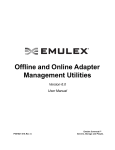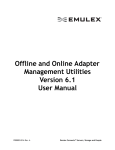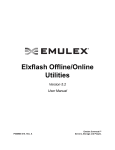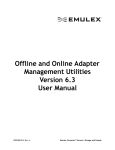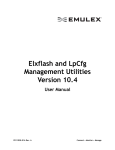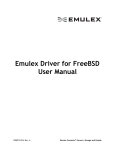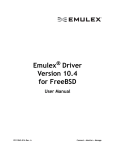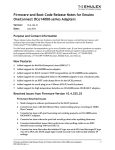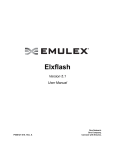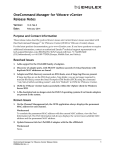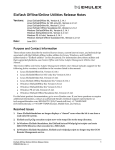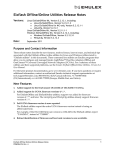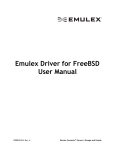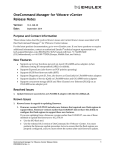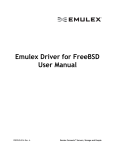Download User Manual
Transcript
Offline and Online Adapter
Management Utilities
Version 6.2
User Manual
P008704-01A Rev. A
Emulex Connects™ Servers, Storage and People
2
Copyright © 2003-2012 Emulex. All rights reserved worldwide. No part of this document may be reproduced by any
means or translated to any electronic medium without the prior written consent of Emulex.
Information furnished by Emulex is believed to be accurate and reliable. However, no responsibility is assumed by
Emulex for its use; or for any infringements of patents or other rights of third parties which may result from its use. No
license is granted by implication or otherwise under any patent, copyright or related rights of Emulex.
Emulex, the Emulex logo, AutoPilot Installer, AutoPilot Manager, BlockGuard, Connectivity Continuum,
Convergenomics, Emulex Connect, Emulex Secure, EZPilot, FibreSpy, HBAnyware, InSpeed, LightPulse, MultiPulse,
OneCommand, OneConnect, One Network. One Company., SBOD, SLI, and VEngine are trademarks of Emulex. All
other brand or product names referenced herein are trademarks or registered trademarks of their respective
companies or organizations.
Emulex provides this manual "as is" without any warranty of any kind, either expressed or implied, including but not
limited to the implied warranties of merchantability or fitness for a particular purpose. Emulex may make
improvements and changes to the product described in this manual at any time and without any notice. Emulex
assumes no responsibility for its use, nor for any infringements of patents or other rights of third parties that may
result. Periodic changes are made to information contained herein; although these changes will be incorporated into
new editions of this manual, Emulex disclaims any undertaking to give notice of such changes.
Emulex, 3333 Susan Street
Costa Mesa, CA 92626
Offline and Online Adapter Management Utilities Version 6.2 User Manual
P008704-01A Rev. A
Table of Contents
Table of Contents
1. Introduction .....................................................................................8
Offline Adapter Management Utility............................................................... 8
Online Adapter Management Utility ............................................................... 8
Key Capabilities........................................................................................ 9
Switches ............................................................................................ 9
Supported Platforms.................................................................................. 9
2. Installation..................................................................................... 10
Platform Pre-requisites ............................................................................ 10
Linux ...............................................................................................10
Offline Adapter Management Utility .............................................................. 10
Offline Adapter Standalone Management Utility................................................ 10
Online Adapter Management Utility .............................................................. 10
Offline Adapter Management Utility - NIC Only ................................................. 10
Installing the Offline Adapter Management Utility for Linux ............................... 11
Updating...........................................................................................11
Uninstalling .......................................................................................11
Installing the Online Adapter Management Utility for Linux ............................... 12
Updating...........................................................................................12
Uninstalling .......................................................................................12
Installing the Offline Adapter Management Utility for Linux (NIC Only) ................. 12
Updating...........................................................................................13
Uninstalling .......................................................................................13
Installing the Offline Adapter Management Utility for Windows........................... 13
Updating...........................................................................................14
Uninstalling .......................................................................................14
Installing the Online Adapter Management Utility for Windows ........................... 14
Updating...........................................................................................14
Uninstalling .......................................................................................14
Offline Adapter Management Utility Installation for FreeBSD.............................. 15
Updating...........................................................................................15
Uninstalling .......................................................................................15
Extracting the Offline Adapter Standalone Management Utility........................... 16
Firmware and Boot Code Prefixes ............................................................... 17
Sample Configuration File ......................................................................18
Offline and Online Adapter Management Utilities Version 6.2 User Manual
P008704-01A Rev. A
3
Table of Contents
3. Adapter Management Utility Command Line Interface ............................... 21
Auto-Discovery (/auto) ............................................................................. 21
Downgrade (/downgrade or /g) ................................................................... 21
Force Firmware and Boot Code (/f or /ff /fb) ................................................. 23
Force Boot Code (/fb) .............................................................................. 24
Force Firmware (/ff)................................................................................ 25
Firmware Matrix Directory Change (/fmd) ..................................................... 26
Firmware Flash Override (/fo).................................................................... 26
Help (/h or /?) ........................................................................................ 26
Image Directory Change (/id) ..................................................................... 26
Image Version Display (/iv) ........................................................................ 27
Log (/log) .............................................................................................. 27
Preview (/p) .......................................................................................... 27
Process FC HBAs Only (/fc) ........................................................................ 29
Process UCNAs Only (/ucna)....................................................................... 29
Query (/q)............................................................................................. 29
Ramdrive (/ramdrive) - (Windows Offline Adapter Management Utility only) .......... 30
Remote (/remote) - (Online Adapter Management Utility only) ........................... 30
Rewrite (/rewrite or /e)............................................................................ 30
Silent (/s).............................................................................................. 32
Update (/update) .................................................................................... 32
Verbose (/v) .......................................................................................... 34
XML Output (/xml) .................................................................................. 34
4. Offline Adapter Management Utility Command Line Interface ..................... 35
Command Syntax .................................................................................... 35
Running the Offline Adapter Management Utility from the Command Prompt ......... 36
Running the Standalone Adapter Management Utility ....................................... 37
Supported Commands .............................................................................. 38
Viewing the Syntax for Commands (help or ?)...............................................40
Resetting an Adapter (reset)...................................................................41
Running the Power-On Self-Test (posttest) ..................................................41
Viewing Adapter Information ..................................................................... 41
Viewing Emulex Conventional Names Instead of Vital Product Data (VPD)
(- /c) ...............................................................................................41
Viewing the Offline Adapter Management Utility Version Information
(version) ...........................................................................................42
Offline and Online Adapter Management Utilities Version 6.2 User Manual
P008704-01A Rev. A
4
Table of Contents
Viewing Vital Product Data (VPD) .............................................................42
Viewing Boot Device Information (readbootdevice) ........................................43
Viewing BootBIOS Versions (listboot) .........................................................43
Viewing all Adapters in the System (listhba) ................................................43
Viewing the WWN of All Adapters in the System (listwwn) ...............................44
Viewing the MAC Address (listmac) ...........................................................45
Viewing Firmware Program Revisions (listrev) ..............................................45
Viewing Selected Configuration Regions (readconfig) .....................................46
Firmware and Boot Code Download Commands............................................... 46
Downloading a File (download) ................................................................46
Accessing the Flash Device Directly (directdownload) .....................................46
World Wide Name Commands..................................................................... 48
Writing WWN and Updating NVPARMS (writewwn) .........................................48
Saving WWN data to a file (savewwn) ........................................................49
Restoring WWN and Updating NVPARMS (restorewwn).....................................49
Restoring NVPARMS (restorenvwwn) ..........................................................49
Restoring the IEEE address (restoredefwwn) ................................................50
Boot Code Commands .............................................................................. 50
Enabling or Disabling BootBIOS or Boot Code (enableboot/disableboot) ...............50
Selecting a Boot Device (setbootdevice) .....................................................51
Enabling or Disabling Boot Devices (enablebootdevice/disablebootdevice)............51
Read All Alternative Boot Devices - readaltboot............................................51
Selecting One or More Alternate Boot Devices (setaltboot)...............................52
Configuration Commands .......................................................................... 53
Updating Configuration Regions (config) .....................................................53
Update by Name ..................................................................................... 53
Update by Number................................................................................... 53
Viewing Personality Information (personalityInfo) ........................................... 54
Changing Personality Information (changePersonality) ..................................... 54
Running Tests ........................................................................................ 54
Running the External Loopback Test (extloopback) ........................................55
Running the Internal Loopback Test (intloopback) .........................................55
Running the PCI Loopback Test (pciloopback) ..............................................56
Using Script Files .................................................................................... 56
Creating Script Files .............................................................................56
Script File Commands ...........................................................................57
Repeating a Series of Commands (repeat) ....................................................... 57
Enabling or Disabling Test Messages on the Screen (screendisplay) ......................... 58
Updating Non-volatile WWNN (scriptwwnn) ..................................................... 58
Offline and Online Adapter Management Utilities Version 6.2 User Manual
P008704-01A Rev. A
5
Table of Contents
Updating Non-volatile WWPN (scriptwwpn) ..................................................... 59
Updating Volatile WWNN (scriptvwwnn) ......................................................... 59
Updating Volatile WWPN (scriptvwwpn) ......................................................... 60
Creating a Log (logfile) .........................................................................61
5. Offline and Online Adapter Management Utility Status Messages .................. 63
Status Messages When Using the fwmatrix.txt File .......................................... 63
Status Messages When Using Auto-Discovery .................................................. 64
6. Offline Adapter Management Utility Error Codes...................................... 66
7. Troubleshooting .............................................................................. 69
Unsupported Driver ................................................................................. 69
Updating Adapters without Boot Code .......................................................... 69
Offline and Online Adapter Management Utilities Version 6.2 User Manual
P008704-01A Rev. A
6
List of Tables
List of Tables
Table
Table
Table
Table
Table
Table
2-1
2-2
4-1
5-1
5-2
6-1
Firmware and Boot Code Prefixes ......................................................17
Emulex Adapter Model Name Equivalents .............................................19
Supported Commands ....................................................................38
fwmatrix.txt File Status Messages ......................................................63
Auto-Discovery Status Messages ........................................................64
Offline Adapter Management Utility Error Codes ....................................66
Offline and Online Adapter Management Utilities Version 6.2 User Manual
P008704-01A Rev. A
7
1. Introduction
Offline Adapter Management Utility
1. Introduction
This document explains how to prepare the adapter management utility kits for Linux
and Windows pre-boot environments.
Offline Adapter Management Utility
The Offline Adapter Management Utility kits allow you to configure Emulex® adapters
before you install or boot a server operating system. You can also use a standalone
Offline Adapter Management utility. See “Running the Standalone Adapter
Management Utility” on page 37 for more information.
Caution:
The adapter must not be connected to any device or fabric while the Linux
offline utility is in use.
The offline utility includes:
winlpcfg
linlpcfg
See “Offline Adapter Management Utility Command Line Interface” on page 35 for
further information on the offline utility.
Online Adapter Management Utility
The Online Adapter Management Utility uses a command line interface allowing you
to build scripts for automated and unattended firmware and boot code download
solutions for Emulex LightPulse® Fibre Channel Host Bus Adapters (HBAs) and
OneConnectTM Universal Converged Network Adapters (UCNAs). For simplicity, this
document refers to HBAs and UCNAs as adapters.
You can download firmware and boot code on local and remote machines
simultaneously.
The Online Adapter Management Utility uses auto-discovery (/auto) so you do not
need to maintain the fwmatrix.txt configuration file. When auto-discovery is invoked,
the utility automatically discovers local adapters and performs selected operations such
as: /ff (force firmware), /fb (force boot), /update, /downgrade, and /rewrite.
When using auto-discovery you must populate the firmware and boot subdirectories
with image files for specific adapter models. Auto-discovery requires the use of Emulex
defined firmware and boot code file names in their respective directories.
If you do not want to use auto-discovery, the Online Adapter Management Utility can
update the firmware or boot code of an adapter using the fwmatrix.txt configuration
file. When using the fwmatrix.txt file you must update each supported adapter's type,
firmware, and boot code entries and place the corresponding firmware and boot code
images into their respective directories. The fwmatrix.txt file enables all operations that
are used with auto-discovery.
Offline and Online Adapter Management Utilities Version 6.2 User Manual
P008704-01A Rev. A
8
1. Introduction
Key Capabilities
Key Capabilities
Key capabilities include:
Switches
The following switches are available on all versions of the utility unless otherwise
indicated:
/auto – Auto-discovers adapters and does not use the fwmatrix.txt
configuration file.
/downgrade – Downgrades firmware or boot code if the downgrade version is
less than the version that is currently installed on an adapter.
/fb – Forces a boot code download on an adapter. /fb is not available in the
ElxflashOfffline_NIC_Only build.
/fc – Process FC HBAs only.
/ff – Forces a firmware download on an adapter.
/fo – Uses the flash executable on supported UCNAs.
/fmd=<directory> – Changes the base directory where fwmatrix.txt is located.
/id=<directory> – Changes the base directory where the firmware and boot
code directories are located.
/iv=<image_version> – Displays an image file's version.
/p – Previews a download of firmware or boot code.
/rewrite – Explicitly re-flashes the firmware or boot code on an adapter if the
rewrite version is equal to or higher than the version currently installed on the
adapter.
/s – Mutes all output to stdout.
/ucna – Processes UCNAs only.
/update – Updates firmware or boot code if the update version is greater than
the version currently installed on an adapter.
/vpd – Displays the VPD model name, instead of the Emulex model name, on
supported adapters
/xml – Displays utility output in xml format.
Supported Platforms
The online and offline applications can be installed on Windows and Linux.
For supported adapters, and supported versions of operating systems and platforms,
see the Emulex website.
Offline and Online Adapter Management Utilities Version 6.2 User Manual
P008704-01A Rev. A
9
2. Installation
Platform Pre-requisites
2. Installation
Platform Pre-requisites
Linux
The Linux platform requires additional software, such as libraries, to run the different
versions of the Offline/Online utility. These pre-requisites are listed below.
Offline Adapter Management Utility
libnl library
Offline Adapter Standalone Management Utility
libnl library
Online Adapter Management Utility
OneCommand Core or Enterprise Kit
Offline Adapter Management Utility - NIC Only
RHEL 5.6, 5.7, 5.8 and later
Inbox NIC driver
ethtool
libsysfs
RHEL 6.1, 6.2 and later
Inbox NIC driver
ethtool
libsysfs
SLES 10 SP4, SLES 11 SP1, and SLES 11 SP2
Inbox NIC driver
ethtool
sysfsutils
Note: For SLES 10 SP4, you can use the DUD (Driver Update Disk) NIC driver
4.0.359.0s or later as an option.
Offline and Online Adapter Management Utilities Version 6.2 User Manual
P008704-01A Rev. A
10
2. Installation
Installing the Offline Adapter Management Utility for Linux
Installing the Offline Adapter Management Utility for
Linux
To install the Offline Adapter Management utility for Linux:
1. Untar the installation tar ball.
2. Run the install script located on the root of the installation kit.
The install script determines the correct architecture and distribution, and performs the
following operations:
1. Installs the packaged LPFC driver only if an LPFC driver RPM is not currently
installed.
2. Installs the packaged NIC driver only if a NIC driver RPM is not currently installed.
3. Installs the packaged iSCSI driver only if an iSCSI driver RPM is not currently
installed.
4. Attempts to update the existing ElxflashOffline and Elxlinlpcfg RPMs. If there are
no existing ElxflashOffline or Elxlinlpcfg RPMs, the install script installs the
packaged ElxflashOffline and Elxlinlpcfg RPMs.
Example:
$ tar zxvf elxflashOffline-<platforms>-<version>-<rel>.tgz
$ cd elxflashOffline-<platforms>-<version>-<rel>
$ ./install.sh
Updating
With an existing Offline Adapter Management utility for Linux installation, run the
install.sh script to update the ElxflashOffline and Elxlinlpcfg RPMs.
Note: During an update, only the ElxflashOffline and Elxlinlpcfg RPMs are updated.
Existing lpfc, NIC, and iSCSI driver RPMs are not updated.
Uninstalling
To uninstall the Offline Adapter Management Utility for Linux, run the uninstall script
located on the root of the installation kit.
The uninstall script executes specific actions depending on the switches that are used.
./uninstall.sh – Uninstall ElxflashOffline and Elxlinlpcfg.
./uninstall.sh -f – Uninstall ElxflashOffline, Elxlinlpcfg and LPFC driver.
./uninstall.sh -n – Uninstall ElxflashOffline, Elxlinlpcfg, and NIC drivers.
./uninstall.sh -s – Uninstall ElxflashOffline, Elxlinlpcfg, and iSCSI drivers.
./uninstall.sh -u – Uninstall ElxflashOffline, Elxlinlpcfg, NIC, iSCSI and LPFC
drivers.
./uninstall.sh -h – Display a summary of all available switches.
Offline and Online Adapter Management Utilities Version 6.2 User Manual
P008704-01A Rev. A
11
2. Installation
Installing the Online Adapter Management Utility for Linux
Example:
$ cd elxflashOffline-<platforms>-<version>-<rel>
$ ./uninstall.sh
Installing the Online Adapter Management Utility for
Linux
To install the Online Adapter Management utility for Linux:
1. Untar the elxflashOnline tar ball that matches the target architecture and operating
system.
2. Copy the elxflashOnline-<version>-<rel> directory to the directory you choose.
Example:
$ tar zxvf elxflashOnline-<platforms>-<version>-<rel>.tgz
$ cd elxflashOnline-<platforms>-<version>-<rel>/<arch>/<os>
Note: To run the Online Adapter Management Utility, you must install the
OneCommand Manager application and the adapter drivers. These components
are not included in the Online Adapter Management Utility - Linux Kit.
Updating
To update the Online Adapter Management utility for Linux, untar the new version
and delete the old version.
Uninstalling
To uninstall the Online Adapter Management utility for Linux, remove the
elxflashOnline-<platforms>-<version>-<rel> directory that was created during
installation.
Example:
$ rm -rf elxflashOnline-<platforms>-<version>-<rel>
Installing the Offline Adapter Management Utility for
Linux (NIC Only)
To install the Offline Adapter Management utility for Linux (NIC only):
1. Untar the installation tar ball.
2. Run the install script located on the root of the installation kit.
The install script determines the correct architecture and distribution, and attempts to
upgrade the existing ElxflashOffline and Elxlinlpcfg RPMs. If there are no existing
ElxflashOffline or Elxlinlpcfg RPMs, the install script installs the packaged
ElxflashOffline and Elxlinlpcfg RPMs.
Offline and Online Adapter Management Utilities Version 6.2 User Manual
P008704-01A Rev. A
12
2. Installation
Installing the Offline Adapter Management Utility for Windows
Example:
$ tar zxvf elxflashOffline_NIC Only-<platforms>-<version>-<rel>.tgz
$ cd elxflashOffline-<platforms>-<version>-<rel>
$ ./install.sh
Updating
To update the Offline Adapter Management utility for Linux (NIC only), run the
install.sh script to upgrade the ElxflashOffline RPM.
Note: During an update, only the ElxflashOffline RPM is updated.
Uninstalling
To uninstall the Offline Adapter Management utility for Linux (NIC only), run the
uninstall script located on the root of the installation kit.
The uninstall script executes specific actions depending on what switches are used.
Note: The following uninstall scripts should not be used on the Citrix operating
system.
./uninstall.sh – Uninstall ElxflashOffline and Elxlinlpcfg.
./uninstall.sh -f, --uninstall_lpfc – Uninstall ElxflashOffline, Elxlinlpcfg and
LPFC driver.
./uninstall.sh -n, --uninstall_nic – Uninstall ElxflashOffline, Elxlinlpcfg, and
NIC drivers.
./uninstall.sh -s, --uninstall_iscsi – Uninstall ElxflashOffline, Elxlinlpcfg, and
iSCSI drivers.
./uninstall.sh -u, --uninstall_all – Uninstall ElxflashOffline, Elxlinlpcfg, NIC,
iSCSI, and LPFC drivers.
./uninstall.sh -h - Display a summary of all available switches.
Example:
$ cd elxflashOffline-<platforms>-<version>-<rel>
$ ./uninstall.sh
Installing the Offline Adapter Management Utility for
Windows
To install the Offline Adapter Management utility for Windows:
1. Unzip the Offline-WinPE-<version>-<rel>.zip.
2. Change the directory to the correct architecture subdirectory.
3. Run the setupElxAll-<arch>.exe.
The following components are installed:
Offline and Online Adapter Management Utilities Version 6.2 User Manual
P008704-01A Rev. A
13
2. Installation
Installing the Online Adapter Management Utility for Windows
Storport UCNA driver
Storport Fibre Channel (FC) driver
OneConnect iSCSI and NIC drivers
WinLpCfg
Offline Adapter Management Utility
Updating
With an existing Offline Adapter Management utility for Windows installation, run the
Offline-WinPE-<arch>-<version>-<rel>.exe.
The installer uninstalls the existing version and then installs the updated version.
Uninstalling
To uninstall the Offline Adapter Management utility for Windows, run the following
commands:
X:\>cd "X:\ProgramData\Tarma
Installer\{AE1F1CA1-B626-4447-9208-14607187EC3D}"
X:\>setup.exe /remove
Installing the Online Adapter Management Utility for
Windows
To install the Online Adapter Management utility for Windows:
1. Unzip the ElxflashOnline-windows-<version>-<rel>.zip file.
2. Copy the win32 or x64 directory to the directory you choose.
Note: To run the Online Adapter Management Utility, you must install the
OneCommand Manager application and the adapter drivers. These components
are not included in the Online Adapter Management Utility for Windows.
Updating
To update the Online Adapter Management utility for Windows, unzip the new
version and delete the old version.
Uninstalling
To uninstall the Online Adapter Management utility for Windows, remove the win32
or x64 directory that was created during installation.
Offline and Online Adapter Management Utilities Version 6.2 User Manual
P008704-01A Rev. A
14
2. Installation
Offline Adapter Management Utility Installation for FreeBSD
Offline Adapter Management Utility Installation for
FreeBSD
The Offline Adapter Management Utility installation for FreeBSD uses an install script.
The install script determines the correct architecture and distribution, and performs the
following operations:
Unloads the NIC driver, if it is loaded.
Installs the packaged NIC driver.
Installs ElxflashOffline utility and LinLpCfg.
Temporarily mounts /proc.
Note: For security reasons, /proc is not mounted by default, however, Elxflash and
LinLpCfg require that /proc be mounted in order to run. Verify /proc is
mounted before running Elxflash or LinLpCfg
To install the Offline Adapter Management utility for FreeBSD:
1. Untar the installation tar ball.
2. Run the install script located on the root of the installation kit.
For example:
# tar xvf elxflashOffline-<platforms>-<version>-<rel>.tgz
# cd elxflashOffline-<platforms>-<version>-<rel>
# ./install.sh
Updating
To update the Offline Adapter Management utility for FreeBSD, uninstall the old
version and then unzip the new version.
Uninstalling
To uninstall the Offline Adapter Management utility for FreeBSD:
Run the uninstall script located on the root of the installation kit.
For example:
# cd elxflashOffline-<platforms>-<version>-<rel>
# ./uninstall.sh
Offline and Online Adapter Management Utilities Version 6.2 User Manual
P008704-01A Rev. A
15
2. Installation
Extracting the Offline Adapter Standalone Management Utility
Extracting the Offline Adapter Standalone
Management Utility
The Offline Adapter Standalone Management utility is not installed; you must extract it
from its zip file. Once you extract the utility, the following directories are created with
the Linux executables in the lx\ directory and the Windows executables in the win\
directory.
boot\
firmware\
lx\
win\
In Windows for example, three directories should be visible in the kit's root directory
after you extract the standalone utility:
# dir
07/05/2012
07:02 PM
<DIR>
.
07/05/2012
07:02 PM
<DIR>
..
07/02/2012
03:14 PM
<DIR>
boot
07/02/2012
03:14 PM
<DIR>
firmware
07/02/2012
03:15 PM
<DIR>
win
The top level boot directory and firmware directory are the default directories where
elxflash looks for firmware and boot code images. Ensure that firmware and boot code
are located in these directories.
The Offline Adapter Standalone Management utility has the same dependencies as
Offline utility. See “Platform Pre-requisites” on page 10.
Note: There are no update or uninstall procedures for the Offline Adapter Standalone
Management utility.
Offline and Online Adapter Management Utilities Version 6.2 User Manual
P008704-01A Rev. A
16
2. Installation
Firmware and Boot Code Prefixes
Firmware and Boot Code Prefixes
Table 2-1 provides the Emulex model names, corresponding firmware, and
corresponding boot code file name prefixes. Use the Elxflash Model name with the
highest protocol as the 'hbatype' name argument in the string in the fwmatrix.txt file
(see Table 2-2, Emulex Adapter Model Name Equivalents, on page 19).
The F/W File Prefix column lists the two letters that begin the name of the
appropriate firmware file name.
The Boot File Prefix column lists the two letters that begin the name of the boot
code file name images:
xU=Universal boot
xB=x86Boot
xO=OpenBoot
xP=Pair Boot (x86+EFI)
xE=EFIBoot.
Table 2-1 Firmware and Boot Code Prefixes
Emulex Adapter Model
Port Type
F/W File Prefix Boot File Prefix
LP11000
FC
BD
BU, BB, BO, BE
LP11002
FC
BF
BU, BB, BO, BE
LP1105
FC
BF
BU, BB, BO, BE
LP1150
FC
JF
JB, JP, JE
LPe11000
FC
ZD
ZU, ZB, ZO, ZE
LPe11002
FC
ZF
ZU, ZB, ZO, ZE
LPem11002
FC
ZF
ZU, ZB, ZO, ZE
LPe11004
FC
ZF
ZU, ZB, ZO, ZE
LPem11004
FC
ZF
ZU, ZB, ZO, ZE
LPe1150
FC
WF
WB, WP, WE
LPe12000
FC
UD
UU, UB, UO, UE
LPSe12000
FC
FD
FU
LPe12002
FC
UD
UU, UB, UO, UE
LPSe12002
FC
FD
FU
LPem12002
FC
UD
UU, UB, UO, UE
LPe12004
FC
UD
UU, UB, UO, UE
LPe1250
FC
OF
OB, OP, OE
LPe1252
FC
OF
OB, OP, OE
LPe16000
FC
A
N/A
LPe16002
FC
A
N/A
Offline and Online Adapter Management Utilities Version 6.2 User Manual
P008704-01A Rev. A
17
2. Installation
Firmware and Boot Code Prefixes
Table 2-1 Firmware and Boot Code Prefixes (Continued)
Emulex Adapter Model
Port Type
F/W File Prefix Boot File Prefix
OCe10102
FCoE
oc
N/A
OCe10102
iSCSI
oc
N/A
OCe10102
NIC
oc
N/A
OCe11101
FCoE
oc
N/A
OCe11101
iSCSI
oc
N/A
OCe11101
NIC
oc
N/A
OCe11102
FCoE
oc
N/A
OCe11102
iSCSI
oc
N/A
OCe11102
NIC
oc
N/A
Sample Configuration File
//
//
//
//
//
//
//
//
//
//
//
//
//
//
//
Example FWMATRIX.TXT
This is a tab delimited file forming a table of firmware and boot code
image file names associated with each HBA type.
Note: All firmware image files are expected to be in the
sub-directory named "firmware".
Note: All boot code image files are expected to be in the
sub-directory named "boot".
These entries and the actual image filenames are case sensitive.
Note: The HBA types are always Emulex model names.
// hbatype
firmware
bootcode
LP11000
BD282A4.ALL
BU512A2.PRG
LP11002
BF282A4.ALL
BU512A2.PRG
LP1105
BF282A4.ALL
BU512A2.PRG
LP1150
JF282A4.ALL
JP512A2.PRG
LPe11000
ZD282A4.ALL
ZU512A2.PRG
LPe11002
ZF282A4.ALL
ZU512A2.PRG
LPe11004
ZF282A4.ALL
ZU512A2.PRG
LPem11002
ZF282A4.ALL
ZU512A2.PRG
LPem11104
ZF282A4.ALL
ZU512A2.PRG
LPe1150
WF282A4.ALL
WP512A2.PRG
LPSe12000
FD110A6.ALL
FU512A3.PRG
LPSe12002
FD110A6.ALL
FU512A3.PRG
Offline and Online Adapter Management Utilities Version 6.2 User Manual
P008704-01A Rev. A
18
2. Installation
Firmware and Boot Code Prefixes
LPe12000
UD201A2.ALL
UU512A2.PRG
LPe12002
UD201A2.ALL
UU512A2.PRG
LPe12004
UD201A2.ALL
UU512A2.PRG
LPe12202
UD201A2.ALL
UU512A2.PRG
LPe12204
UD201A2.ALL
UU512A2.PRG
LPem12002
UD201A2.ALL
UU512A2.PRG
LPe1250
OF200A4.ALL
OP512A2.PRG
LPe1252
OF200A4.ALL
OP512A2.PRG
LPe16000
A1033.GRP
LPe16002
A1033.GRP
Emulex Adapter Model Name Equivalents
Table 2-2 Emulex Adapter Model Name Equivalents
Emulex Model
Elxflash ‘hbatype’
Port Type
LP1050EX
LP1050
FC
LPe1150
LPe1150
FC
LPe11002
LPe11002
FC
LPe11004
LPe11004
FC
LP1150
LP1150
FC
LP11002
LP11002
FC
LP1105-HP (Mezzanine)
LP1105
FC
LP1050DC (Mezzanine)
LP1050DC
FC
LPe12000
LPe12000
FC
LPe12002
LPe12002
FC
LPe12004
LPe12004
FC
LPe1250
LPe1250
FC
LPe16000
LPe16000
FC
LPe16002
LPe16002
FC
OCe10102
OCe10100-FCoE
FCoE
OCe10102
OCe10100-iSCSI
iSCSI
OCe10102
OCe10100-NIC
NIC
OCe11101
OCe11100-FCoE
FCoE
OCe11101
OCe11100-iSCSI
iSCSI
OCe11101
OCe11100-NIC
NIC
OCe11102
OCe11100-FCoE
FCoE
OCe11102
OCe11100-iSCSI
iSCSI
Offline and Online Adapter Management Utilities Version 6.2 User Manual
P008704-01A Rev. A
19
2. Installation
Firmware and Boot Code Prefixes
Table 2-2 Emulex Adapter Model Name Equivalents (Continued)
Emulex Model
Elxflash ‘hbatype’
Port Type
OCe11102
OCe11100-NIC
NIC
Firmware images are available on the Emulex support site at:
http://www.emulex.com.
Note: OneConnect models (FCoE, iSCSI, and NIC) may share the same Emulex model
name, but may run different protocols. For example, an Emulex model
OCe10102 can be an FCoE, iSCSI, or NIC UCNA.
When the fwmatrix.txt file is used, the Elxflash “hbatype” must include the highest
protocol being used on that model. An adapter's “hbatype” can be seen by running the
/Query command. For example:
# ./elxflash /q
HBA=OCe11100-iSCSI, Port Type=iSCSI, MAC=00:00:C9:AD:AD:21, PCI ID=712, VID=19A2,
SSID=E702, SVID=10DF, Firmware=4.0.493.0, Boot Code=2.0.21.768
HBA=OCe11100-iSCSI, Port Type=iSCSI, MAC=00:00:C9:AD:AD:25, PCI ID=712, VID=19A2,
SSID=E702, SVID=10DF, Firmware=4.0.493.0, Boot Code=2.0.21.768
HBA=OCe11100-iSCSI, Port Type=NIC, MAC=00:00:C9:AD:AD:20, PCI ID=710, VID=19A2,
SSID=E702, SVID=10DF, Firmware=4.0.493.0, Boot Code=2.0.21.768
HBA=OCe11100-iSCSI, Port Type=NIC, MAC=00:00:C9:AD:AD:24, PCI ID=710, VID=19A2,
SSID=E702, SVID=10DF, Firmware=4.0.493.0, Boot Code=2.0.21.768
elxflash.exe: All required queries succeeded - Return Code=0
The OCe11100 UCNA in the example above is an iSCSI adapter.
Offline and Online Adapter Management Utilities Version 6.2 User Manual
P008704-01A Rev. A
20
3. Adapter Management Utility Command Line Interface
Auto-Discovery (/auto)
3. Adapter Management Utility Command Line
Interface
There are two supported modes for each Adapter Management Utility switch. The first
mode relies on the fwmatrix.txt file. It is your responsibility to update the fwmatrix.txt
file, firmware and boot code directories with the appropriate firmware and boot code
images.
The second mode is auto-discovery. When the /auto switch is used with /ff, /fb,
/downgrade, /rewrite, or /update, the Adapter Management Utility auto discovers
adapters and, using the firmware and boot subdirectories, performs the specified
operation on each adapter.
Auto-Discovery (/auto)
Usage: /auto
The auto-discovery switch instructs the Adapter Management Utility to ignore the
fwmatrix.txt file, automatically discover local adapters, and perform specified
operations (/f, /ff, /fb, /downgrade, /rewrite, or /update) using the firmware and
boot directories.
The /auto switch must be used with an additional operational switch (/f, /ff, /fb,
/downgrade, /rewrite, or /update).
Example usage:
./elxflash /auto /update – Updates the firmware and boot code using the firmware
and boot directories.
The fwmatrix.txt file is ignored. You must place the desired versions of
firmware in the firmware directory.
Using the firmware subdirectory, the Adapter Management Utility
automatically discovers the best matching firmware for each installed and
supported adapter.
If multiple versions of firmware or boot code are found for an adapter, the
Adapter Management Utility uses the highest version when performing the
firmware download.
Downgrade (/downgrade or /g)
Usage: /downgrade or /g
The downgrade switch downgrades the firmware or boot code of each adapter if the
currently installed versions are higher than the downgrade versions. This switch
cannot be used with the /update or /rewrite commands.
Example usage:
./elxflash /downgrade /auto – Downgrades the firmware or boot code using
auto-discovery.
Offline and Online Adapter Management Utilities Version 6.2 User Manual
P008704-01A Rev. A
21
3. Adapter Management Utility Command Line Interface
Downgrade (/downgrade or /g)
The fwmatrix.txt file is ignored. You must place the desired downgrade
versions of firmware or boot code in their respective directories.
If the downgrade versions are lower than the currently installed versions on the
adapter, then the downgrade versions are downloaded to the adapter.
If multiple downgrade versions of firmware or boot code are found for an
adapter, the next-previous downgrade versions are downloaded to the adapter.
When performing the boot code downgrade operation, the Adapter
Management Utility first tries to match by adapter family and boot type. If a
match is not found, the Adapter Management Utility then tries to match by boot
type. If the utility is matching by boot type and multiple versions of boot code
are detected, downgrade always chooses in the following order:
1.
2.
3.
4.
5.
Universal (U)
Pair (P)
Open (O)
EFI (E)
x86 (B)
./elxflash /downgrade – Downgrades the firmware or boot code using the fwmatrix.txt
file.
For each installed and supported adapter, the current firmware or boot code
versions are compared with the versions specified in fwmatrix.txt.
If the downgrade versions in fwmatrix.txt are lower than the currently installed
versions, the downgrade versions of firmware or boot code are downloaded to
that adapter.
LightPulse Adapter Download Summary
<date><time>
HBA=<model>, Port Type=<port_type>, WWN=<wwn>,
Update=<Boot Code|Firmware>, Image=<image>, New=<version>,
Old=<version>, Status=<description>
FCoE Adapter Download Summary
<date><time>
HBA=<model>, Port Type=<port_type>, WWN=<wwn>,
Update=Firmware, Image=<image>, New=<version>, Old=<version>,
Status=<description>
iSCSI and NIC-only Adapter Summary
<date><time>
HBA=<model>, Port Type=<port_type>, MAC=<mac_address>,
Update=Firmware, Image=<image>, New=<version>, Old=<version>,
Status=<description>
Return Code=<n>
Offline and Online Adapter Management Utilities Version 6.2 User Manual
P008704-01A Rev. A
22
3. Adapter Management Utility Command Line Interface
Force Firmware and Boot Code (/f or /ff /fb)
where <description> is Success or Error and <n> = 0 for completion with no errors and
a non-zero error code for any error.
Notes:
FCoE, iSCSI, and NIC-only adapters require a system reboot to activate new
firmware.
If the preview switch is also used, the Status=<description> field is not
displayed.
Force Firmware and Boot Code (/f or /ff /fb)
Usage: /f -or- /ff /fb
The Force Firmware and Boot Code switch forces a firmware and boot code download
to an adapter regardless of the current version on the adapter. When this switch is used,
a Force Firmware and Boot Code operation is performed regardless of any additional
switches given on the command line.
Example usage:
./elxflash /f /auto – Forces a firmware and boot code download using auto-discovery.
The fwmatrix.txt file is ignored. You must place the desired versions of
firmware and boot code in their respective directories.
If multiple versions of firmware or boot code are found for an adapter, the
Adapter Management Utility uses the highest versions when performing the
firmware and boot code downloads.
./elxflash /f – Forces a firmware and boot code download using the fwmatrix.txt file.
For each installed and supported adapter, forces a download of firmware and
boot code using the versions specified in the fwmatrix.txt file.
LightPulse Adapter Download Summary
<date><time>
HBA=<model>, Port Type=<port_type>, WWN=<wwn>,
Update=<Boot Code|Firmware>, Image=<image>, New=<version>,
Old=<version>, Status=<description>
FCoE Adapter Download Summary
<date><time>
HBA=<model>, Port Type=<port_type>, WWN=<wwn>,
Update=Firmware, Image=<image>, New=<version>, Old=<version>,
Status=<description>
Offline and Online Adapter Management Utilities Version 6.2 User Manual
P008704-01A Rev. A
23
3. Adapter Management Utility Command Line Interface
Force Boot Code (/fb)
iSCSI and NIC-only Adapter Summary:
<date><time>
HBA=<model>, Port Type=<port_type>, MAC=<mac_address>,
Update=Firmware, Image=<image>, New=<version>, Old=<version>,
Status=<description>
Return Code=<n>
where <description> is Success or Error and <n> = 0 for completion with no errors and
a non-zero error code for any error.
Notes:
FCoE, iSCSI, and NIC-only adapters require a system reboot to activate new
firmware.
If the preview switch is also used, the Status=<description> field is not
displayed.
Force Boot Code (/fb)
Usage: /fb
The Force Boot Code switch forces a boot code download to an adapter regardless of
what boot code the adapter currently has installed. When this switch is used, a Force
Boot Code operation is performed regardless of any additional switches given on the
command line.
Example usage:
./elxflash /fb /auto – Forces a boot code download using auto-discovery.
The fwmatrix.txt file is ignored. You must place the desired versions of boot
code in the boot directory.
If multiple versions of boot code are found for an adapter, the Adapter
Management Utility uses the highest version when performing the boot code
download.
./elxflash /fb – Forces a boot code download using the fwmatrix.txt file.
For each installed and supported adapter, forces a download of boot code using
the boot code version specified in the fwmatrix.txt file.
LightPulse Adapter Download Summary
<date><time>
HBA=<model>, Port Type=<port_type>, WWN=<wwn>,
Update=Boot Code, Image=<image>, New=<version>, Old=<version>,
Status=<description>
Return Code=<n>
where <description> is Success or Error and <n> = 0 for completion with no errors and
a non-zero error code for any error.
Offline and Online Adapter Management Utilities Version 6.2 User Manual
P008704-01A Rev. A
24
3. Adapter Management Utility Command Line Interface
Force Firmware (/ff)
Note: If the preview switch is also used, the Status=<description> field is not
displayed.
Force Firmware (/ff)
Usage: /ff
The Force Firmware switch forces a firmware download to an adapter regardless of
what firmware the adapter currently has installed. When this switch is used, a Force
Firmware operation is performed regardless of any additional switches given on the
command line.
Example usage:
./elxflash /ff /auto – Forces a firmware download using auto-discovery.
The fwmatrix.txt file is ignored. You must place the desired versions of
firmware in the firmware directory.
If multiple versions of firmware are found for an adapter, the Adapter
Management Utility uses the highest version when performing the firmware
download.
./elxflash /ff – Forces a firmware download using the fwmatrix.txt file.
For each installed and supported adapter, forces a download of firmware using
the firmware version specified in the fwmatrix.txt file.
LightPulse and FCoE Adapter Download Summary
<date><time>
HBA=<model>, Port Type=<port_type>, WWN=<wwn>,
Update=Firmware, Image=<image>, New=<version>, Old=<version>,
Status=<description>
iSCSI and NIC-only Adapter Summary
<date><time>
HBA=<model>, Port Type=<port_type>, MAC=<mac_address>,
Update=Firmware, Image=<image>, New=<version>, Old=<version>,
Status=<description>
Return Code=<n>
where <description> is Success or Error and <n> = 0 for completion with no errors and
a non-zero error code for any error.
Notes:
FCoE, iSCSI, and NIC-only adapters require a system reboot to activate new
firmware.
If the preview switch is also used, the Status=<description> field is not
displayed.
Offline and Online Adapter Management Utilities Version 6.2 User Manual
P008704-01A Rev. A
25
3. Adapter Management Utility Command Line Interface
Firmware Matrix Directory Change (/fmd)
Firmware Matrix Directory Change (/fmd)
Usage: /fmd=<directory>
The firmware matrix directory change switch changes the location of the base directory
where fwmatrix.txt is located.
Firmware Flash Override (/fo)
Usage: /fo
The flash override switch is used to execute a firmware download using the flash
executable on supported UCNAs.
Note: The Flash Override command applies to Linux ElxflashOffline only.
Example usage:
./elxflash /f /auto /fo – Forces a firmware and boot code download using
auto-discovery and downloads the firmware to supported UCNAs using the flash
executable.
The fwmatrix.txt file is ignored. The desired versions of firmware and boot code
must be placed in their respective directories.
If multiple versions of firmware and boot code are found for an adapter,
Elxflash uses the highest versions when performing the firmware and boot code
downloads.
The flash executable is used to download firmware to supported UCNAs.
Example usage:
./elxflash /f /fo – Forces a firmware and boot code download using the
fwmatrix.txt file and downloads the firmware to supported UCNAs using the flash
executable.
For each installed and supported adapter, a forced download of firmware and
boot code occurs using the versions specified in the fwmatrix.txt file.
The flash executable is used to download firmware to supported UCNAs.
Help (/h or /?)
Usage: /h or /?
The help switch displays a help message detailing instructions on how to use the
Adapter Management Utility.
Image Directory Change (/id)
Usage: /id=<image_directory>
The image directory switch is used to specify the location of the firmware and boot
code directories.
Offline and Online Adapter Management Utilities Version 6.2 User Manual
P008704-01A Rev. A
26
3. Adapter Management Utility Command Line Interface
Image Version Display (/iv)
Example usage:
./elxflash /f /auto /id=/tmp – Forces a firmware and boot code download using
auto-discovery. Elxflash looks for the firmware and boot code directories in the /tmp
directory.
The fwmatrix.txt file is ignored. The desired versions of firmware and boot code
must be placed in their respective directories.
In this example firmware must be placed in the /tmp/firmware directory and
boot code must be placed in the /tmp/boot directory.
If multiple versions of firmware and/or boot code are found for an adapter,
Elxflash uses the highest versions when performing the firmware and boot code
downloads.
./elxflash /f /i=/tmp – Forces a firmware and boot code download using the
fwmatrix.txt file. Elxflash look for the firmware and boot code directories in the /tmp
directory.
For each installed and supported adapter, a forced download of firmware and
boot code occurs using the versions specified in the fwmatrix.txt file.
In this example firmware must be placed in the /tmp/firmware directory and
boot code must be placed in the /tmp/boot directory.
Note: This switch was “/i” in previous versions of the online/offline utility.
Image Version Display (/iv)
Usage: /iv=<image file>
The image version display switch displays the firmware image file’s version number.
Example usage:
./elxflash /iv=A11100.grp 1.1.10.0
Log (/log)
Usage: /log=<logfile.txt>
The log switch appends the output of the Adapter Management Utility to a text file.
Log can be used with any switch.
Preview (/p)
Usage: /p
The preview switch provides you with a download preview of all adapters that the
Adapter Management Utility can update using either auto-discovery or the
fwmatrix.txt file. The preview switch can be used with any of the operational switches
such as: force firmware, force boot, downgrade, rewrite, and update. When the preview
switch is used, the Adapter Management Utility displays a download summary, but
does not actually perform the download.
Offline and Online Adapter Management Utilities Version 6.2 User Manual
P008704-01A Rev. A
27
3. Adapter Management Utility Command Line Interface
Preview (/p)
Each adapter's download preview displays the adapter's old and new image version.
The old image version represents the image version that is currently on the adapter.
The new image version represents the image version that the Adapter Management
Utility would use during a download.
Example usage:
./elxflash /preview /auto /update – Previews an upgrade of firmware or boot
code using auto-discovery.
The fwmatrix.txt file is ignored. You must place the desired update versions of
firmware or boot code in their respective directories.
If the update versions are higher than the currently installed versions on the
adapter, the Adapter Management Utility provides a download preview for
each adapter that can be updated.
If multiple update versions of firmware or boot code are found for an adapter,
the Adapter Management Utility provides a download preview using the
highest versions.
./elxflash /preview – Previews an upgrade of firmware or boot code using the
fwmatrix.txt file.
For each installed and supported adapter, the current firmware and boot code
versions are compared with the versions specified in fwmatrix.txt.
If the update versions in fwmatrix.txt are higher than the currently installed
versions, the Adapter Management Utility provides a download preview of
firmware or boot code for each adapter that can be updated.
LightPulse Adapter Download Summary
<date><time>
HBA=<model>, Port Type=<port_type>, WWN=<wwn>,
Update=<Boot Code|Firmware>, Image=<image>, New=<version>,
Old=<version>, Status=Preview
FCoE Adapter Download Summary
<date><time>
HBA=<model>, Port Type=<port_type>, WWN=<wwn>,
Update=Firmware, Image=<image>, New=<version>, Old=<version>,
Status=Preview
iSCSI and NIC-only Adapter Download Summary
<date><time>
HBA=<model>, Port Type=<port_type>, MAC=<mac_address>,
Update=Firmware, Image=<image>, New=<version>, Old=<version>,
Status=Preview
Offline and Online Adapter Management Utilities Version 6.2 User Manual
P008704-01A Rev. A
28
3. Adapter Management Utility Command Line Interface
Process FC HBAs Only (/fc)
Process FC HBAs Only (/fc)
Usage: /fc
The Process FC HBAs Only switch causes elxflash to only act on FC HBAs.
Example usage:
./elxflash /q /fc - Only FC HBAs are displayed for a query.
./elxflash /auto /up /fc - Applies auto update only to FC HBAs.
When doing a firmware or boot code update and the /fc switch is used, only FC HBAs
are updated; UCNAs are not displayed.
Note: /fc is not available on ElxflashOffline_NIC_only.
Process UCNAs Only (/ucna)
Usage: /ucna
The Process UCNA Only switch causes elxflash to only act on UNCAs.
Example usage:
./elxflash /q /ucna - For a query only UCNAs are displayed.
./elxflash /auto /up /ucna - Apply auto update only to UCNAs.
When doing a firmware or boot code update and the /ucna switch is used, only
UCNAs are updated; FC HBAs are not displayed.
Query (/q)
Usage: /q
The query switch displays an adapter's model, WWN or MAC address, PCI_ID,
firmware version, and boot code version. Query can be used with any switch.
LightPulse Adapter Status Summary
HBA=<model>, Port Type=<port_type>, WWN =<wwn>, Firmware=<version>,
Boot Code=<version>, Boot Code enable=<status>
FCoE Adapter Status Summary
HBA=<model>, Port Type=<port_type>, WWN =<wwn>, Firmware=<version>,
iSCSI and NIC-only Adapter Status Summary
HBA=<model>, Port Type=<port_type>, MAC =<mac_address>,
Firmware=<version>,
Offline and Online Adapter Management Utilities Version 6.2 User Manual
P008704-01A Rev. A
29
3. Adapter Management Utility Command Line Interface
Ramdrive (/ramdrive) - (Windows Offline Adapter Management Utility only)
Notes:
On LightPulse adapters, the query switch displays boot code version
information only if the adapter has boot code installed.
When the query switch is used with an operational switch, the query also
includes an additional field called “Supported Firmware” or “Supported Boot
Code”.
Ramdrive (/ramdrive) - (Windows Offline Adapter
Management Utility only)
Usage: /ramdrive=<drive letter>[:]
The ramdrive switch specifies the drive for creating temporary and log files. The
default is drive X.
Remote (/remote) - (Online Adapter Management
Utility only)
Usage: /remote
The remote switch enables updates on remote in-band adapters.
Rewrite (/rewrite or /e)
Usage: /rewrite -or- /e
The rewrite switch updates the firmware or boot code of each adapter if the currently
installed versions are less than or equal to the rewrite versions. This switch cannot be
used with /update or /downgrade.
Example usage:
./elxflash /rewrite /auto – Rewrites the firmware boot code using
auto-discovery.
The fwmatrix.txt file is ignored. You must place the desired rewrite versions of
firmware or boot code in their respective directories.
If the rewrite versions are higher than or equal to the versions installed on the
adapter, then the rewrite versions are downloaded to the adapter.
If multiple rewrite versions of firmware or boot code are found for an adapter,
the highest versions are downloaded to the adapter.
When performing the boot code rewrite operation, the Adapter Management
Utility first tries to match by adapter family and boot type. If a match is not
found, the Adapter Management Utility then tries to match by boot type. If the
utility is matching by boot type, and multiple versions of boot code are
detected, rewrite always chooses in the following order:
Offline and Online Adapter Management Utilities Version 6.2 User Manual
P008704-01A Rev. A
30
3. Adapter Management Utility Command Line Interface
Rewrite (/rewrite or /e)
1.
2.
3.
4.
5.
Universal (U)
Pair (P)
Open (O)
EFI (E)
x86 (B)
./elxflash /rewrite – Rewrites the firmware or boot code using the fwmatrix.txt
file.
For each installed and supported adapter, the current firmware or boot code
versions are compared with the versions in fwmatrix.txt.
If the currently installed versions are less than or equal to the rewrite versions in
fwmatrix.txt then the rewrite versions of firmware or boot code are downloaded
to the adapter.
LightPulse Adapter Download Summary
<date><time>
HBA=<model>, Port Type=<port_type>, WWN=<wwn>,
Update=<Boot Code|Firmware>, Image=<image>, New=<version>,
Old=<version>, Status=<description>
FCoE Adapter Download Summary
<date><time>
HBA=<model>, Port Type=<port_type>, WWN=<wwn>,
Update=Firmware, Image=<image>, New=<version>, Old=<version>,
Status=<description>
iSCSI and NIC-only Adapter Download Summary
<date><time>
HBA=<model>, Port Type=<port_type>, MAC=<mac_address>,
Update=Firmware, Image=<image>, New=<version>, Old=<version>,
Status=<description>
Return Code=<n>
where <description> is Success or Error and <n> = 0 for completion with no errors and
a non-zero error code for any error.
Notes:
FCoE, iSCSI, and NIC-only adapters require a system reboot to activate new
firmware.
If the preview switch is also used, the Status =<description> field is not
displayed.
Offline and Online Adapter Management Utilities Version 6.2 User Manual
P008704-01A Rev. A
31
3. Adapter Management Utility Command Line Interface
Silent (/s)
Silent (/s)
Usage: /s
The silent switch mutes all output to stdout.
Example usage:
./elxflash /f /auto /s – Forces a firmware and boot code download using
auto-discovery and mutes all output to stdout.
The fwmatrix.txt file is ignored. The desired versions of firmware and boot code
must be placed in their respective directories.
If multiple versions of firmware and/or boot code are found for an adapter,
Elxflash uses the highest versions when performing the firmware and boot code
downloads.
No output is printed to stdout.
./elxflash /f /s – Forces a firmware and boot code download using the
fwmatrix.txt file and mutes all output to stdout.
For each installed and supported adapter, a download of firmware and boot
code is forced using the versions specified in the fwmatrix.txt file.
No output is printed to stdout.
Update (/update)
Usage: /update
The update switch updates the firmware or boot code of each adapter if the currently
installed versions are less than the update versions. This switch cannot be used with
/downgrade or /rewrite.
Example usage:
./elxflash /update /auto – Upgrades the firmware or boot code using
auto-discovery.
The fwmatrix.txt file is ignored. You must place the desired update versions of
firmware or boot code in their respective directories.
If the update versions are higher than the currently installed versions on the
adapter then the update versions are downloaded to the adapter.
If multiple update versions of firmware or boot code are found for an adapter,
the highest versions are downloaded to the adapter.
When performing the boot code update operation, the Adapter Management
Utility uses the highest boot code version found. Since multiple compatible
versions of boot code may exist, the highest version is selected in the following
order:
Offline and Online Adapter Management Utilities Version 6.2 User Manual
P008704-01A Rev. A
32
3. Adapter Management Utility Command Line Interface
Update (/update)
1.
2.
3.
4.
5.
Universal (U)
Pair (P)
Open (O)
EFI (E)
x86 (B)
Note: The highest boot code version is downloaded regardless of the installed
boot code. This allows upgrading from one type of boot code to another
type.
./elxflash /update – Upgrades the firmware or boot code using the fwmatrix.txt
file.
For each installed and supported adapter, the current firmware and boot code
versions are compared with the versions specified in fwmatrix.txt.
If the update versions in fwmatrix.txt are higher than the currently installed
versions then the update versions of firmware or boot code are downloaded to
that adapter.
LightPulse Adapter Download Summary
<date><time>
HBA=<model>, Port Type=<port_type>, WWN=<wwn>,
Update=<Boot Code|Firmware>, Image=<image>, New=<version>,
Old=<version>, Status=<description>
FCoE Adapter Download Summary
<date><time>
HBA=<model>, Port Type=<port_type>, WWN=<wwn>,
Update=Firmware, Image=<image>, New=<version>, Old=<version>,
Status=<description>
iSCSI and NIC-only Adapter Download Summary
<date><time>
HBA=<model>, Port Type=<port_type>, MAC=<mac_address>,
Update=Firmware, Image=<image>, New=<version>, Old=<version>,
Status=<description>
Return Code=<n>
where <description> is Success or Error and <n> = 0 for completion with no errors and
a non-zero error code for any error.
Note: FCoE, iSCSI, and NIC-only adapters require a system reboot to activate new
firmware.
Offline and Online Adapter Management Utilities Version 6.2 User Manual
P008704-01A Rev. A
33
3. Adapter Management Utility Command Line Interface
Verbose (/v)
Verbose (/v)
Usage: /v
The verbose switch displays progress messages and can be used with any switch. When
this switch is used, the following information is displayed:
A download summary for all adapters that had successful or failed downloads.
A summary of unsupported adapters, if applicable.
A per adapter message for each adapter that the Adapter Management Utility
did not update.
LightPulse Adapter Download Summary
<date><time>
HBA=<model>, Port Type=<port_type>, WWN=<wwn>,
Update=<Boot Code|Firmware>, Image=<image>, New=<version>,
Old=<version>, Status=<description>
FCoE Adapter Download Summary
<date><time>
HBA=<model>, Port Type=<port_type>, WWN=<wwn>,
Update=Firmware, Image=<image>, New=<version>, Old=<version>,
Status=<description>
iSCSI and NIC-only Adapter Download Summary
<date><time>
HBA=<model>, Port Type=<port_type>, MAC=<mac_address>,
Update=Firmware, Image=<image>, New=<version>, Old=<version>,
Status=<description>
Return Code=<n>
where <description> is Success or Error and <n> = 0 for completion with no errors and
a non-zero error code for any error.
XML Output (/xml)
Usage: /xml
The xml switch displays utility output in xml format.
Offline and Online Adapter Management Utilities Version 6.2 User Manual
P008704-01A Rev. A
34
4. Offline Adapter Management Utility Command Line Interface
Command Syntax
4. Offline Adapter Management Utility
Command Line Interface
The Offline Adapter Management Utility allows you to configure Emulex adapters
before you install or boot a server operating system.
Caution:
Under Linux, the Offline Adapter Management Utility is for offline use
only. The adapter must not be connected to any device or fabric while the
Linux Offline Adapter Management Utility is in use.
The Offline Adapter Management Utility includes:
winlpcfg
linlpcfg
You can use the Offline Adapter Management Utility to do the following:
View information on an Emulex adapter
Reset the adapter
Download firmware and boot code files
Select a boot device
Read and update world wide names (WWNs)
Enable boot code
Update configuration regions
Set the adapter to use soft jumpers
Run diagnostic tests
Read and process script files
Command Syntax
In all cases, the commands are given with the prefix os. When you enter any command,
you must replace the os with either:
win – for the WinPE Offline Adapter Management Utility commands for use on
WinPE machines.
./lin – for the Linux Offline Adapter Management Utility commands for use on
Linux machines.
The Offline Adapter Management Utility commands are not case-sensitive, nor are
their arguments. You can enter them in upper, lower, or mixed case. However, for
Linux operating systems, Emulex recommends using linlpcfg (all lowercase) for the
Offline Adapter Management Utility commands (for example, ./linlpcfg listhba).
The Offline Adapter Management Utility commands require both:
One space between the command name and the first argument.
One space between additional arguments.
Offline and Online Adapter Management Utilities Version 6.2 User Manual
P008704-01A Rev. A
35
4. Offline Adapter Management Utility Command Line Interface
Running the Offline Adapter Management Utility from the Command Prompt
Note: Do not put a space before or after the equal sign within an argument.
WWN values are reported and specified with two 4-byte hexadecimal words – WWN
word 0 (w0) and WWN word 1 (w1). Concatenate the w0 and w1 values to make the
full WWN.
Running the Offline Adapter Management Utility
from the Command Prompt
Note: You must start the WinPE and Linux Offline Adapter Management Utility at the
command prompt.
1. Boot the system with a supported operating system.
2. Start the Offline Adapter Management Utility with a valid command or a valid
script file name.
To start an Offline Adapter Management Utility from the command line, move
to the directory where the executable file resides and type
oslpcfg <valid command> (replace os with ./lin or win as appropriate)
For example, starting the WinPE Offline Adapter Management Utility with
a reset command:
winlpcfg reset n=2
For example, starting the Linux Offline Adapter Management Utility with a
reset command:
./linlpcfg reset n=2
To start an Offline Adapter Management Utility with a script file name, from
the directory where the oslpcfg.exe file resides, type
oslpcfg @<script file name>
For example, starting an Offline Adapter Management Utility with
script1.txt in the c:\test directory:
oslpcfg @C:\test\script1.txt
Note: To redirect screen output to a file, add <filename> at the end of each command.
For example:
oslpcfg listboot n=1 >result.out
Note: For more information on script files, see “Creating Script Files” on page 56 and
“Script File Commands” on page 57.
Offline and Online Adapter Management Utilities Version 6.2 User Manual
P008704-01A Rev. A
36
4. Offline Adapter Management Utility Command Line Interface
Running the Standalone Adapter Management Utility
Running the Standalone Adapter Management Utility
The Standalone Adapter Management Utility allows you to update firmware on
Emulex adapters without needing to install any tools. No drivers are included in the
Standalone kit. No applications are installed because the utility runs from inside the kit.
The Standalone Adapter Management Utility has the same capability as the Offline
Adapter Management Utility, except that you use the following scripts to run the
utility:
Windows – winlpcfg.bat and elxflash.bat
Linux – linplcfg.sh and elxflash.sh
For example in Windows:
After extracting the standalone utility, change to the win directory from the kit’s
root directory. The following files are present:
# cd win
07/02/2012
03:15 PM
<DIR>
.
07/02/2012
03:15 PM
<DIR>
..
07/02/2012
03:15 PM
07/02/2012
03:15 PM
07/02/2012
03:15 PM
07/02/2012
03:15 PM
25,786 elxflash.bat
<DIR>
win32
25,786 winlpcfg.bat
<DIR>
x64
The elxflash.bat script is used to run elxflash.exe, which behaves like previous
versions of elxflash.exe. The winlpcfg.bat script is used to run winlpcfg.exe. It also
behaves like previous versions of winlpcfg.exe.
To update firmware and bootcode on an adapter in Windows, type
# elxflash.bat /auto /up
To display a list of HBAs in Windows, type
# winlpcfg.bat
listhba
from the Win directory
Note: The adapter being managed by the Standalone Adapter Management utility
must not be simultaneously managed by other Emulex utilities including
OneCommand Manager.
Each time elxflash or lpcfg are run a log file is created. On Windows these files are
called:
C:\clu\log\elxflash.log
C:\clu\log\winlpcfg.log
On Linux these files are called:
/var/log/clu/elxflash.log
/var/log/clu/linlpcfg.log
Offline and Online Adapter Management Utilities Version 6.2 User Manual
P008704-01A Rev. A
37
4. Offline Adapter Management Utility Command Line Interface
Supported Commands
Supported Commands
Table 13-1 lists all Offline Adapter Management Utility commands that are supported
or not supported on Emulex traditional LightPulse HBAs and OneConnect adapters on
various platforms.
indicates commands are supported on both WinLpCfg and LinLpCfg.
L indicates commands are supported only on LinLpCfg.
FCoE only indicates commands are supported only by FCoE UCNAs.
Table 4-1 Supported Commands
FCoE, NIC, and iSCSI
Adapters
FC Adapters
COMMANDS
X86
X64
IA64
PPC
X86
X64
RH 5.6+
RH 5.6+
RH 5.6+
RH 5.6+
RH 5.6+
RH 5.6+
RH 6.1+
RH 6.1+
RH 6.1+
RH 6.1+
RH 6.1+
SLES 11.1+ SLES 11.1+ SLES 11.1+ SLES 11.1+
SLES 11.1+
SLES 11.1+
WinPE 2.x
WinPE 2.x
WinPE 2.x
WinPE 2.x
L
FCoE only
FCoE only
L
L
L
L
N/A
N/A
DisableBoot
L
N/A
N/A
disableBootDevice
L
FCoE
FCoE
N/A
N/A
N/A
N/A
L
EnableBoot
L
FCoE
FCoE
enableBootDevice
L
FCoE
FCoE
extLoopback
L
Help
L
intLoopback
L
ListBoot
L
N/A
N/A
ListHBA
L
Operating
Systems
Config
See Note 7 page 40
DirectDownload
See Note 7 page 40
DmaTest
See Note 1 page 40
See Note 7 page 40
Download
See Note 5 page 40
See Note 2 page 40
See Note 3 page 40
See Note 4 page 40
Offline and Online Adapter Management Utilities Version 6.2 User Manual
P008704-01A Rev. A
38
4. Offline Adapter Management Utility Command Line Interface
Supported Commands
Table 4-1 Supported Commands (Continued)
FCoE, NIC, and iSCSI
Adapters
FC Adapters
COMMANDS
X86
X64
IA64
PPC
X86
X64
listRev
L
FCoE only
FCoE only
listMAC
N/A
N/A
N/A
N/A
NIC
NIC
listWWN
L
FCoE only
FCoE only
logFile
L
pciLoopback
L
FCoE only
FCoE only
postTest
L
N/A
N/A
personalityInfo
N/A
N/A
N/A
N/A
changePersonality
N/A
N/A
N/A
N/A
readAltBoot
L
FCoE only
FCoE only
readBootDevice
L
FCoE only
FCoE only
readConfigc
L
FCoE only
FCoE only
reset
L
FCoE only
FCoE only
restoreDefWWN
L
FCoE only
FCoE only
restoreNVWWN
L
FCoE only
FCoE only
restoreWWN
L
FCoE only
FCoE only
saveWWN
L
FCoE only
FCoE only
screenDisplay
L
FCoE only
FCoE only
scriptVWWNN
L
FCoE only
FCoE only
scriptVWWPN
L
FCoE only
FCoE only
scriptWWNN
L
FCoE only
FCoE only
scriptWWPN
L
FCoE only
FCoE only
setAltBoot
L
FCoE only
FCoE only
setBootDevice
L
FCoE only
FCoE only
Version
L
VPD See Note 6 on
page 40
L
writeWWN
L
FCoE only
FCoE only
See Note 7 page 40
Offline and Online Adapter Management Utilities Version 6.2 User Manual
P008704-01A Rev. A
39
4. Offline Adapter Management Utility Command Line Interface
Supported Commands
Notes on Supported Commands
DmaTest is supported on OneConnect adapters only.
Syntax:
DmaTest n=<adapter index> p=<pattern> c=<byte count> r=<repeat count>
p: 3 to 8-HEX byte pattern
c: 64 to 4096
r: 1 to 4096
An external loopback plug is required. Syntax for OneConnect adapters:
extLoopback n=<adapter index> p=<pattern> c=<byte count> r=<repeat count>
p: 3 to 8-HEX byte pattern
c: 1500 to 8192
r: 1 to 4096
Syntax for OneConnect adapters:
Note: An internal loopback plug is required.
intLoopback n=<adapter index> p=<pattern> c=<byte count> r=<repeat count>
t=<type>
p: 3 to 8-HEX byte pattern
c: 1500 to 8192
r: 1 to 4096
t: 2
The listHBA command displays all HBAs installed in the systems, OneConnect
adapters included with all basic properties: Serial number, Physical number,
Universal CNA type, NIC-Only/iSCSI/FCoE type.
The download command does not support a= <adapter name> with
OneConnect adapters.
VPD is supported for the following UCNA functions:
OCe10102, FCoE functions only
OCe11102, FCoE functions, NIC and iSCSI functions
VPD is supported for all FC devices.
The Config, DirectDownload, DmaTest, and postTest commands are not
supported by the LPe16000 or LPe16002 adapters.
Viewing the Syntax for Commands (help or ?)
To view the syntax for all available commands, type
oslpcfg help
or
oslpcfg ?
To view the syntax for a specific command, type
oslpcfg help <command>
or
oslpcfg ? <command>
Offline and Online Adapter Management Utilities Version 6.2 User Manual
P008704-01A Rev. A
40
4. Offline Adapter Management Utility Command Line Interface
Viewing Adapter Information
For example, either:
oslpcfg help download
or
oslpcfg ? download
returns a response similar to the following:
download <n=adapter> <i=imagepath>
or
download <a=adaptertype> <i=imagepath>
Resetting an Adapter (reset)
This command resets a specific adapter or all adapters in the system.
Syntax:
To reset one adapter, type
oslpcfg reset n=<adapter number>
To reset all adapters in the system, type
oslpcfg reset n=all
Running the Power-On Self-Test (posttest)
This command runs the power-on self-test (POST) on the selected adapter.
To run the adapter POST test, type
oslpcfg posttest n=<all/adapter number>
The following example runs the POST test on adapter #1.
oslpcfg posttest n=1
Viewing Adapter Information
Viewing Emulex Conventional Names Instead of Vital
Product Data (VPD) (- /c)
Adding a - /c to any command that uses the parameter a= to return adapter data causes
the command to return an Emulex conventional model for the adapter rather than the
model name in the adapter. The following commands use the -/c operator:
config
download
directdownload
Offline and Online Adapter Management Utilities Version 6.2 User Manual
P008704-01A Rev. A
41
4. Offline Adapter Management Utility Command Line Interface
Viewing Adapter Information
Examples of Emulex conventional model names:
LPe12000
LPe11002
LP10000DC
Example of model names in (usually OEM) VDP data:
LPe1104-M4
Viewing the Offline Adapter Management Utility Version
Information (version)
This command shows the Offline Adapter Management Utility version information.
To view this information, type
oslpcfg version
Viewing Vital Product Data (VPD)
This command shows the VPD of the adapter specified by its number.
To display VPD, type
oslpcfg vpd n=<adapter number>
The following examples show VPD output:
WinLpCfg.exe vpd n=1
Sample legacy FC response:
Product Name
: LPe12002, 8GB/S, 2-PORT, FC, PCI EXPRESS HBA, DIAG, OPTICS
PN (Part Number)
:LPE12002-M8
SN (Serial Number)
:VM80175529
V0
:VM80175529
V1
:Emulex LPe12002-M8 8Gb 2-port PCIe Fibre Channel Adapter
V2
:LPe12002-M8
V3
:T2:78,T3:79,7A,7B,7D,7E,7F,T7:73,TB:73,TFF:78
V4
:0
Command completed, NO Error
Sample LPe 16000 HBA response:
Product Name
:Emulex LightPulse LPe16002-M6-D 2-Port 16Gb Fibre Channel
Adapter, FC PF
PN (Part Number)
:LPe16002-M6-D
SN (Serial Number)
:99999999
MN (Manufacture ID)
:1028
VS
:DSV1028VPDR.VER1.0
VP
:NPY2
Offline and Online Adapter Management Utilities Version 6.2 User Manual
P008704-01A Rev. A
42
4. Offline Adapter Management Utility Command Line Interface
Viewing Adapter Information
VM
:PMT7
VV
:NMVEMULEX CORPORATION
VT
:DTINIC
V0
:99999999
V1
:Emulex LightPulse LPe16002-M6-D 2-Port 16Gb Fibre Channel
Adapter
V2
:LPe16002-M6-D
Command completed, NO Error
Viewing Boot Device Information (readbootdevice)
This command shows the WWN, the LUN (in decimal format), and the topology in use
for the currently selected boot device.
To show this information, type
oslpcfg readbootdevice n=<adapter number>
The following example reads WWN and LUN for adapter #1:
oslpcfg readbootdevice n=1
Note: The readbootdevice command does not read boot device settings for EFI (IA64)
adapter boot. This command is supported only for x86 and x86_64 adapter boot
configurations. You can modify or show EFI boot settings using hbacmd or the
EFI shell.
Viewing BootBIOS Versions (listboot)
This command lists all the BootBIOS versions, with indices (base 1) and code names,
that are loaded in the flash of the adapter, specified by its number. If the selected
adapter does not have any BootBIOS loaded, it returns error code 39.
To list BootBIOS versions, type
oslpcfg listboot n=<adapter number>
The following example lists BootBIOS versions that are loaded on adapter #3:
oslpcfg listboot n=3
Viewing all Adapters in the System (listhba)
This command lists all installed adapters in the system. Information includes the
adapter number (base 1), the Institute of Electrical and Electronic Engineers (IEEE)
address assigned by the manufacturer, the functional firmware, the adapter type, and
possible mailbox errors.
To list all adapters in the system, type
oslpcfg listhba
Offline and Online Adapter Management Utilities Version 6.2 User Manual
P008704-01A Rev. A
43
4. Offline Adapter Management Utility Command Line Interface
Viewing Adapter Information
Sample response:
HBA 1: FCoE 10000000 C95B3C99 Functional FW: 2.701.126.5 OCe10102-F
HBA 2: FCoE 10000000 C95B3C9B Functional FW: 2.701.126.5 OCe10102-F
HBA 3: 10000000 C95B38CA Functional FW: US1.10N1
LPe12002
HBA 4: 10000000 C95B38CB Functional FW: US1.10N1
LPe12002
HBA 5: 10000000 C951AC67 Functional FW: WS2.50A4
LPe1150-F4
HBA 6: iSCSI
MAC:00.00.c9.5b.3f.f5 devID:702 Port:1 Func:2 Univ:YES OCe10102-I
HBA 7: iSCSI
MAC:00.00.c9.5b.3f.f7 devID:702 Port:0 Func:3 Univ:YES OCe10102-I
HBA 8: NIC
MAC:00.00.c9.5b.3f.f4 devID:700 Port:1 Func:0 Univ:YES OCe10102-I
HBA 9: NIC
MAC:00.00.c9.5b.3f.f6 devID:700 Port:0 Func:1 Univ:YES OCe10102-I
HBA 10: NIC
MAC:00.00.c9.5b.3c.98 devID:700 Port:1 Func:0 Univ:YES OCe10102-F
HBA 11: NIC
MAC:00.00.c9.5b.3c.9a devID:700 Port:0 Func:1 Univ:YES OCe10102-F
Command completed, NO Error!
In this example:
HBAs 1,2, 10, and 11 are FCoE OneConnect UCNAs
HBAs 6-9 are iSCSI OneConnect UCNAs
HBAs 3-5 are LightPulse HBAs
Note: listHBA with option -/c displays the LightPulse HBA conventional model
names instead of the model names contained in the VPD.
Viewing the WWN of All Adapters in the System (listwwn)
This command lists all adapters installed in the system and shows the factory-assigned
WWN, the non-volatile WWPN, and the WWNN used to identify an adapter in the
SAN.
The factory-assigned WWN is an IEEE address that cannot be changed in the field. The
non-volatile WWN can be modified in the field and persists after a restart of the
operating system. The full factory-assigned WWN and non-volatile WWN are a
concatenation of the two 8-character values (word 0 and word 1) that are shown for
each. You can modify the non-volatile WWPN and WWNN using either the writewwn
command or the scriptwwnn and scriptwwnn commands. For more information on the
writewwn command, see “Writing WWN and Updating NVPARMS (writewwn)” on
page 48.
If the system does not have any Emulex adapters installed, it returns error code 45.
To show the WWN information, type:
oslpcfg listwwn
Sample response:
adapter 1: LPe11002
Factory IEEE:
10000000
C92774AF
Non-Volatile WWPN: 10A2A2A2 C92774AF,
WWNN: 20A2A2A2 C92774AF
adapter 2: LPe11002
Factory IEEE:
10000000
C92774AE
Volatile WWPN: 10FFFFFF C92774AE,
WWNN: 20FFFFFF 00000000
adapter 3: LPe11004-M4
Offline and Online Adapter Management Utilities Version 6.2 User Manual
P008704-01A Rev. A
44
4. Offline Adapter Management Utility Command Line Interface
Viewing Adapter Information
Factory IEEE:
10000000
C93CCE08
Non-Volatile WWPN: 10A3A3A3 C93CCE08,
WWNN: 20A3A3A3 C93CCE08
adapter 4: LPe11004-M4
Factory IEEE:
10000000
C93CCE09
Volatile WWPN: 10000000 C93CCE09,
WWNN: 20000000 C93CCE09
Viewing the MAC Address (listmac)
This command shows the MAC address of a NIC UCNA port.
To view the MAC address of a NIC UCNA port, type
oslpcfg listmac n=<adapter number>
Sample response:
adapter 2: NIC Permanent MAC 00-00-c9-5b-3a-f4 MAC 00-00c9-5b3ac2
Viewing Firmware Program Revisions (listrev)
This command shows the firmware versions in the adapter’s flash memory, specified
by their numbers.
To show revisions, type
oslpcfg listrev n=<adapter number>
The following example lists information for adapter #3:
oslpcfg listrev n=3
Sample response:
Chipset Rev:
BIU:
1001206D
SM FW:
0BC12792
FW Rev:
Current FW:
SLI-3 Overlay
Kernel Rev:
FFC01213
Kernel
LP110021.20a3
Init FW:
LP11002Init Load 2.72a2
(BS2.72A2)
SLI-2:
LP11002Overlay 2.72a2
(B2F2.72A2)
SLI-3:
LP11002Overlay 2.72a2
(B3F2.72A2)
FC-PH Version Supported:
Highest FC-PH Version Supported = 4.3
Lowest FC-PH Version Supported = 4.3
Feature Availability = 0000 00ef
Offline and Online Adapter Management Utilities Version 6.2 User Manual
P008704-01A Rev. A
45
4. Offline Adapter Management Utility Command Line Interface
Firmware and Boot Code Download Commands
Viewing Selected Configuration Regions (readconfig)
This command shows the contents of the selected configuration region up to the
initialized length or the specified byte count (if the initialized length is less than the
specified byte count). Valid region numbers are 0 to 32. You must initialize the
configuration region first by, for example, writing data to it.
To read a configuration, type
oslpcfg readconfig n=<adapter number> r=<region number> l=<byte count>
The following example reads the configuration for adapter #1, region 0, byte count 20:
oslpcfg readconfig n=1 r=0 l=20
Sample Response:
00000000:
00000008:
00000010:
10000000
20000000
00000000
c93ccce08
c93ccce08
Firmware and Boot Code Download Commands
Downloading a File (download)
This command downloads a firmware or boot code file to a specific adapter.
Note: This download command is not supported with CEE firmware (used with
LP21002 and LP21000 CNAs).
The adapter name is the name that appears when you run the listHBA command. For
more information on the listHBA command, see “Viewing all Adapters in the System
(listhba)” on page 43.
To download a firmware image file to an adapter specified by its number, type
oslpcfg download n=<adapter number> i=<firmware image filename>
The following example downloads the zb200a1.prg (x86) BootBIOS file to adapter # 6;
in this example, the x86 BootBIOS file is for an LPe11000 adapter:
oslpcfg download n=6 i=zb200a1.prg
Accessing the Flash Device Directly (directdownload)
This command directly accesses the flash device on the adapter without using the
adapter firmware. This feature is useful in downloading a read-only memory (ROM)
file image if the firmware has been corrupted. The adapter name is the name that
appears when you run the listHBA command. You can also use “default” for the
adapter name if there is only one single-channel adapter or one dual-channel adapter in
the system. For more information on the listHBA command, see “Viewing all Adapters
in the System (listhba)” on page 43.
Offline and Online Adapter Management Utilities Version 6.2 User Manual
P008704-01A Rev. A
46
4. Offline Adapter Management Utility Command Line Interface
Firmware and Boot Code Download Commands
Notes:
You cannot use directdownload in a script file.
This command does not support a CEE firmware directdownload.
You can use this feature on the following Emulex adapters:
LP21000 and LP21002
LPe12000, LPe12002 and LPe1250
LPe11000, LPe11002, LPe1150 and LPe11004
LP11002, LP11000 and LP1150
LP10000ExDC and LP1050Ex
LP10000DC and LP10000
LP1005DC-CM2
LP1050 and LP1050DC
To access the flash device on the adapter directly, type (all on one line)
oslpcfg directdownload a=<adapter name/default> i=<firmware image
filename> s=<selection 0 or 1>
where s=1 saves the existing VPD.
The following example accesses the flash device on an LPe12000 HBA:
oslpcfg directdownload a=lpe12000 i=C:\image\ud100a8.rom s=1
The following example accesses the flash device if the offline utility cannot detect the
adapter type and there is only one single-channel adapter or one dual-channel adapter
in the system:
oslpcfg directdownload a=default i=C:\image\ud100a8.rom s=1
Caution:
In versions prior to 5.1 or with option s=0 in version 5.1,the ROM images
used with the directdownload command may not contain certain VPD
information (for example, serial number, adapter model, or manufacturer).
Direct download of a ROM image that has not been confirmed to contain the
correct VPD image updates the board's firmware, but it also clears the VPD.
The board will function. If you use calls for VPD in your applications, the
information may be changed or missing.
Dual-channel adapters include:
LP21002
LPe12002
LPe11002
LP11002
LP10000ExDC
LP10000DC
LP1050DC
Offline and Online Adapter Management Utilities Version 6.2 User Manual
P008704-01A Rev. A
47
4. Offline Adapter Management Utility Command Line Interface
World Wide Name Commands
Four-channel adapters include:
LPe11004
LPe12004
World Wide Name Commands
Writing WWN and Updating NVPARMS (writewwn)
This command allows you to enter word 0 and word 1 of the WWPN or WWNN from
the keyboard or a barcode scanner to update a specified adapter’s non-volatile
parameters (NVPARMS) with a new WWPN or WWNN. The new WWPN and WWNN
are used the next time the adapter is discovered. The adapter stores the original WWPN
and WWNN in another region of the memory so it can be used to identify the adapter
as it was manufactured. The WWN can also be read with a barcode scanner.
Write WWN prompts for the WWPN and WWNN cannot be used in a script file. The
scriptwwnn and scriptwwpn commands use values entered with the command and can
be used in a script file.
Caution:
Use the writewwn command with caution. If you use the same WWPN or
WWNN on more than one adapter in a fabric, unpredictable results may
occur.
Note: Word 0 of WWNN and WWPN names must follow one of the following
formats:
10000xxx
2xxxxxxx
3xxxxxxx
5xxxxxxx
To modify the WWPN and WWNN, type
oslpcfg writewwn n=<adapter number>
The offline utility prompts you to enter new data:
WWPN word 0
WWPN word 1
WWNN word 0
WWNN word 1
The following example writes the WWPN and WWNN for adapter #1.
oslpcfg writewwn n=1
Enter or Scan value for WWPN word 0 now
Enter a value.
10000000
Offline and Online Adapter Management Utilities Version 6.2 User Manual
P008704-01A Rev. A
48
4. Offline Adapter Management Utility Command Line Interface
World Wide Name Commands
The system echoes what you entered, followed by the next prompt:
10000000
Enter or Scan value for WWPN word 1 now
Saving WWN data to a file (savewwn)
This command reads the original words 0 and 1 of the IEEE address, installed by
manufacturing, from configuration regions 16 (or 32) of the adapter (specified by its
number) and saves the configuration region information in the selected WWN file.
To save the WWN data to a file, type
oslpcfg savewwn n=<adapter number> c=<wwn filename>
The following example reads the configuration region information on adapter #4 and
saves it to the contents of the ctwwn.sav file:
oslpcfg savewwn n=4 c=ctwwn.sav
Restoring WWN and Updating NVPARMS (restorewwn)
This command restores words 0 and 1 of the IEEE address from a specified file created
with the savewwn command and uses them to update the NVPARMS port name with
this IEEE address.
To restore the WWN, type
oslpcfg restorewwn n=<adapter number> c=<wwn filename>
The following example updates the NVPARMS on adapter #4 with the ctwwn.sav file.
oslpcfg restorewwn n=4 c=ctwwn.sav
Restoring NVPARMS (restorenvwwn)
This command restores the non-volatile WWPN and WWNN to the adapter, replacing
any volatile WWPN and WWNN data, without powering off the adapter.
If the adapter does not have firmware that supports the volatile WWN, the following
error message appears:
Write Volatile Parms Error. Reported Error 48
If this occurs, install firmware that supports the volatile WWN.
To restore the NVWWN, type
oslpcfg restorenvwwn n=<adapter number>
The following example restores the NVWWN on adapter #2.
oslpcfg restorenvwwn n=2
Offline and Online Adapter Management Utilities Version 6.2 User Manual
P008704-01A Rev. A
49
4. Offline Adapter Management Utility Command Line Interface
Boot Code Commands
Restoring the IEEE address (restoredefwwn)
This command reads the IEEE address (assigned by the manufacturer) and writes it to
the non-volatile WWPN and WWNN.
To restore the defwwn, type
oslpcfg restoredefwwn n=<adapter number>
The following example restores the defwwn on adapter #2.
oslpcfg restoredefwwn n=2
Boot Code Commands
You must enable BootBIOS before you can issue setBootDevice and setAltBoot
commands. If necessary, use the enableboot command to enable BootBIOS. (See
“Enabling or Disabling BootBIOS or Boot Code (enableboot/disableboot)” on page 50
for more information.)
To set the boot device with the offline utility, run the following commands in this order:
1. Use the listboot command to verify that the BootBIOS is present. (See “Viewing
BootBIOS Versions (listboot)” on page 43 for more information.)
Example:
oslpcfg listboot n=1
Sample return:
bootBIOS 1 (enabled): ZB2.01A2
bootBIOS 2 (disabled): ZB2.01A1
2. Use the setbootdevice command to set the boot device. (See “Selecting a Boot
Device (setbootdevice)” on page 51 for more information.)
3. Configure the system BIOS so the adapter boot device is the highest in the boot
order.
Enabling or Disabling BootBIOS or Boot Code
(enableboot/disableboot)
This command enables or disables the BootBIOS (boot code) (selected by its index) for
the specified adapter number. Index i is one of the indices (base 1) shown when you run
the listboot command.
To enable BootBIOS, type
oslpcfg enableboot n=<adapter number> i=<index>
The following example enables BootBIOS on adapter #6:
oslpcfg enableboot n=6 i=1
To disable BootBIOS, type
oslpcfg disableboot n=<adapter number>
Offline and Online Adapter Management Utilities Version 6.2 User Manual
P008704-01A Rev. A
50
4. Offline Adapter Management Utility Command Line Interface
Boot Code Commands
The following example disables BootBIOS on adapter #6:
oslpcfg disableboot n=6
Selecting a Boot Device (setbootdevice)
This command sets the boot device specified by its WWN, LUN, and desired topology.
Set t to 0 for Arbitrated Loop.
Set t to 1 for Point-to-Point.
The selected device boots when the system reboots.
The boot code must be enabled before issuing the setbootdevice command.
To set the boot device, type (all on one line)
oslpcfg setbootdevice n=<adapter number> w0=<wwpn word 0> w1=<wwpn
word 1> l=<Decimal ID of LUN> t=<topology>
Note: Enter the LUN number in decimal format.
The following example sets the boot device on adapter #1, LUN #46 with a desired
topology of Arbitrated Loop:
oslpcfg setbootdevice n=1 w0=a1b2c3d4 w1=b946a4e8 l=46 t=0
Notes:
If port login (PLOGI) fails after 50 msecs, the command is retried once.
The setbootdevice command does not configure boot device settings for EFI
(IA64) adapter boot. This command is supported only for the x86 and x86_64
adapter boot configuration. You can modify or display EFI boot settings using
the EFI shell.
Enabling or Disabling Boot Devices
(enablebootdevice/disablebootdevice)
After using the setBootDevice command, you can enable or disable the boot device by
using the enablebootdevice or disablebootdevice command.
To enable the boot device, type
oslpcfg enablebootdevice n=<adapter number>
To disable the boot device, type
oslpcfg disablebootdevice n=<adapter number>
Read All Alternative Boot Devices - readaltboot
This command shows the WWN and LUN numbers in decimal format of all possible
alternate boot devices. You can have up to seven alternate boot devices.
To read all alternate boot devices, type (all on one line)
oslpcfg readaltboot n=1
Offline and Online Adapter Management Utilities Version 6.2 User Manual
P008704-01A Rev. A
51
4. Offline Adapter Management Utility Command Line Interface
Boot Code Commands
Sample response:
Alt Boot 1Boot Device WWN:
10000000
Boot Device LUN:
1
C920A4D6
Alt Boot 2Boot Device WWN:
10000000
Boot Device LUN:
4
C920A4D8
Alt Boot 3Boot Device WWN:
10000000
Boot Device LUN:
3
C920A4DA
Alt Boot 4Boot Device WWN:
10000000
Boot Device LUN:
2
C920A4DC
Alt Boot 5Boot Device WWN:
10000000
Boot Device LUN:
1
C920A4DE
Alt Boot 6Boot Device WWN:
Boot Device LUN:
10000000
C920A4F2
14
Note: The readaltboot command does not read boot device settings for EFI (IA64)
adapter boot. This command is supported only for x86 and x86_64 adapter boot
configuration. EFI boot settings can be modified or displayed using hbacmd or
the EFI shell.
Selecting One or More Alternate Boot Devices (setaltboot)
This command sets alternate boot devices. You can set up to seven alternate boot
devices, that is, index i can be from 1 to 7.
Note: The boot code must be enabled before you issue the setAltBoot command.
To set up one or more alternate boot devices, type (all on one line)
oslpcfg setaltboot n=<adapter number> i=<index> w0=<wwpn word 0>
w1=<wwpn word 1> l=<Decimal ID of LUN>
The following example set the alternate boot device on adapter #1, LUN #3:
oslpcfg setaltboot n=1 i=1 w0=12345678 w1=a842b6 l=3.
Offline and Online Adapter Management Utilities Version 6.2 User Manual
P008704-01A Rev. A
52
4. Offline Adapter Management Utility Command Line Interface
Configuration Commands
Note: The setaltboot command does not configure boot device settings for EFI (IA64)
adapter boot. This command is supported only for x86 and x86_64 adapter boot
configuration. EFI boot settings can be modified or displayed using hbacmd or
the EFI shell.
Configuration Commands
Updating Configuration Regions (config)
There are two forms of configuration:
Configure all adapters of a given adapter name at once
Configure a single adapter by its number
Valid region numbers range from 0 to 32.
Update by Name
To update a specified configuration region on all adapters of the same selected name,
type (all on one line)
oslpcfg config a=<adapter name> r=<region number> c=<configuration
filename>
Note: The adapter name is the name that appears when you run the listHBA
command. For more information on the listHBA command, see “Viewing all
Adapters in the System (listhba)” on page 43.
The following example updates region 6 of all LP11000 adapters with ctplus1.cfl:
oslpcfg config a=lp11000 r=6 c=ctplus1.cfl
The following example updates region 17 of all ABC24-FC56 adapters with
d:\dfplus1.cfl:
oslpcfg config a=ABC24-FC56 r=17 c=d:\dfplus1.cfl
Note: The size of the .cfl file for configuration region update can be up to 2028 bytes.
Update by Number
To update a specified configuration region for one adapter, type (all on one line)
oslpcfg config n=<adapter number> r=<region number>
c=<configuration filename>
The following example updates region 17 of adapter number 4 with heplus1.cf1:
oslpcfg config n=4 r=17 c=heplus1.cfl
The following example updates region 6 of adapter number 2 with d:\dfplus1.cf1:
oslpcfg config n=2 r=6 c=d:\dfplus1.cfl
Offline and Online Adapter Management Utilities Version 6.2 User Manual
P008704-01A Rev. A
53
4. Offline Adapter Management Utility Command Line Interface
Viewing Personality Information (personalityInfo)
Viewing Personality Information (personalityInfo)
This command displays the current personality and the available personalities.
To view personality information, type
oslpcfg personalityInfo n=<adapter index>
where adapter index is obtained from the listHBA command.
The following example lists the personalityInfo on adapter #3:
oslpcfg personalityInfo n=3
Sample response:
Current Personality: FCoE
Configured Personality: FCoE
Available Personalities:
NIC
iSCSI
FCoE
Command completed, NO Error
Changing Personality Information
(changePersonality)
This command changes the personality of the adapter to the selected one.
To change personality, type
oslpcfg changePersonality n=<adapter index> p=<personality string>
The following example changes the personality information on adapter #3:
oslpcfg changePersonality n=3 p=iSCSI
Sample response:
Please REBOOT the system now to activate the Personality change
Command completed, NO Error
Running Tests
Note: Since the extloopback, intloopback, and pciloopback commands do not support
testing on all installed adapters, the o=3 option applies to running linlpcfg with
the script command. The o=3 option instructs lpcfg to ignore errors and
continue script execution.
Offline and Online Adapter Management Utilities Version 6.2 User Manual
P008704-01A Rev. A
54
4. Offline Adapter Management Utility Command Line Interface
Running Tests
Running the External Loopback Test (extloopback)
This command runs the external loopback test. You must put a loopback plug in each
adapter channel to be tested. You can test a specific adapter in the system. Specify the
number of times you want the test to repeat, and direct the test response if an error is
found.
The option on error choices are:
o=1 stops the test on the first error
o=2 ignores three errors and stops the test on the fourth error
o=3 ignores errors and continues the test
Note: ‘extloopback’ does not support testing all installed adapters using n=all.
To run the external loopback test on LightPulse adapters, type (all on one line)
oslpcfg extloopback n=<adapter number> r=<repeat count> o=<option on error>
Note: You must put a loopback plug in each port tested for extloopback.
To run external loopback test on OneConnect adapters, type (all on one line)
oslpcfg extLoopback n=<adapter index> p=<pattern> c=<byte count> r=<repeat count>
where:
p = 3 to 8-HEX byte pattern
c = 1500 to 8192
r = 1 to 4096
The following example runs the external loopback test 50 times on adapter #1 and stops
the test if an error occurs:
oslpcfg extloopback n=1 r=50 o=1
Running the Internal Loopback Test (intloopback)
This command runs the internal loopback test. You can run the test on a specific
adapter in the system. Specify the number of times you want the test to repeat, and
direct the test response if an error occurs.
The option on error choices are:
o=1 stops the test on the first error
o=2 ignores three errors and stops the test on the fourth error
o=3 ignores errors and continues the test
Notes:
‘intloopback’ does not support testing all installed adapters using n=all.
Do not use the internal loopback test on Emulex blade adapters.
To run the internal loopback test, type (all on one line)
oslpcfg intloopback n=<adapter number> r=<repeat count> o=<option on error>
Offline and Online Adapter Management Utilities Version 6.2 User Manual
P008704-01A Rev. A
55
4. Offline Adapter Management Utility Command Line Interface
Using Script Files
To run internal loopback test on OneConnect adapters, type (all on one line)
oslpcfg intLoopback n=<adapter index> p=<pattern> c=<byte count> r=<repeat count>
t=<type>
where:
p = 3 to 8-HEX byte pattern
c = 1500 to 8192
r = 1 to 4096
t=2
The following example runs the internal loopback test 100 times on adapter #1 and
stops the test if an error occurs:
oslpcfg intloopback n=1 r=100 o=1
Running the PCI Loopback Test (pciloopback)
This command runs the PCI loopback test. You can run the test on a specific adapter or
on all adapters in the system. Specify the number of times you want the test to repeat,
and direct the test response if an error occurs.
The option on error choices are:
o=1 stops the test on the first error
o=2 ignores three errors and stops the test on the fourth error
o=3 ignores errors and continues the test
Note: ‘pciloopback’ does not support testing all installed adapters using n=all.
To run the PCI loopback test, type (all on one line)
oslpcfg pciloopback n=<all/adapter number> r=<repeat count> o=<option on error>
The following example runs the PCI loopback test 100 times on all adapters in the
system and stops the testing if any errors occurs.
oslpcfg pciloopback n=all r=100 o=1
Using Script Files
Creating Script Files
You can group commands together and run them using a script file. You can also enter
comment lines, which begin with a semicolon. Each line follows the same command
syntax as those documented in this manual. The offline utility allows you to:
Run commands entered in a script file. Use the @ command to run the script file.
Run commands multiple times. Add the repeat command as the last line of the
script file.
Create a log of test results. Add the logfile command as the first line of the script
file.
Offline and Online Adapter Management Utilities Version 6.2 User Manual
P008704-01A Rev. A
56
4. Offline Adapter Management Utility Command Line Interface
Using Script Files
To run a script file type:
oslpcfg @<scriptname.txt>
The following example runs the script “script1.txt” that resides in the current directory
and executes all the commands in that script file.
oslpcfg @script1.txt
Note: To interrupt and stop any script, press <S> on the keyboard.
Script File Commands
The following is a sample script file. Each command follows the syntax covered above.
The comment lines begin with a semicolon (;):
version
screendisplay o=0
;download a=lpe11000 i=c:\temp\zd272a2.all
;reset n=1 s=0
;reset n=2 s=0
reset n=all s=0
listboot n=1
enableboot n=1 i=2
; pciloopback n=1 r=10 o=1
; pciloopback n=2 r=10 o=2
; pciloopback n=all r=50 o=3
intloopback n=1 r=10 o=1
intloopback n=2 r=10 o=1
extloopback n=1 r=40 o=3
extloopback n=2 r=40 o=3
;repeat r=10
Repeating a Series of Commands (repeat)
Enter this command at the end of a script file to repeat a series of commands from the
beginning of the script file a specific number of times.
Note: To interrupt and stop the repeat command, press <S> on the keyboard.
To repeat the series of commands in the script file, add the following as the last line of
the file:
repeat r=<repeat count>
The following example repeats the series of commands in the script file 10 times.
repeat r=10
Offline and Online Adapter Management Utilities Version 6.2 User Manual
P008704-01A Rev. A
57
4. Offline Adapter Management Utility Command Line Interface
Using Script Files
Enabling or Disabling Test Messages on the Screen
(screendisplay)
This command enables or disables test message display on the screen.
o=0 – Prevents messages from appearing
o=1 – Enables messages
Note: This command is supported only in script files.
To enable or disable test message displays, add the following line to the script:
screendisplay o=<display option>
In the following script file example, messages from the version and listhba commands
are output to the log file and to the screen. After the screendisplay command is set to 0,
all successive commands (download, listboot and enableboot) result messages are
output only to the log file, not to the screen.
version
listhba
screendisplay o=0
download a=lpe11000 i=c:\temp\zd272a2.all
listboot n=2
enableboot n=2 i=1
Updating Non-volatile WWNN (scriptwwnn)
This command reads the WWNN words 0 and 1 from the command line to update the
non-volatile WWNN. You can also include this command in a script file. When the
adapter is discovered, the new WWNN value is used. The adapter retains the original
WWNN in another region of the firmware.
Caution:
Use the scriptwwnn command with caution. If you use the same WWNN on
more than one adapter in a fabric, unpredictable results may occur.
To change WWNN words 0 and 1 from the command line, type (all in one line)
oslpcfg scriptwwnn n=<adapter number> w0=<wwnn word 0> w1=<wwnn word 1>
The following example updates non-volatile WWNN word 0 and word 1 for adapter
#1:
oslpcfg scriptwwnn n=1 w0=10000345 w1=B620A1B2
Offline and Online Adapter Management Utilities Version 6.2 User Manual
P008704-01A Rev. A
58
4. Offline Adapter Management Utility Command Line Interface
Using Script Files
Notes:
Word 0 of WWNN and WWPN names must follow one of the following
formats:
10000xxx
2xxxxxxx
3xxxxxxx
5xxxxxxx
If the scriptvwwnn command has been used previously, the adapter continues
to use that WWNN until you change the WWNN with the restorenvwwn
command.
Updating Non-volatile WWPN (scriptwwpn)
This command reads WWPN words 0 and 1 from the command line to update the
non-volatile WWPN. You can also include this command in a script file. When it is
discovered, the adapter uses the new WWNN value. It does not use the original IEEE
address assigned by manufacturing (located in Configuration Region 16 or 32).
Caution:
Use the scriptwwnn command with caution. If you use the same WWNN on
more than one adapter in a fabric, unpredictable results may occur.
Note: If the scriptvwwnn command has been used previously, the adapter continues
to use that WWPN until you change the WWPN with the restorenvwwn
command.
To change WWPN words 0 and 1 from the command line, type (all in one line)
oslpcfg scriptwwpn n=<adapter number> w0=<wwpn word 0> w1=<wwpn word
1>
The following example updates the non-volatile WWPN word 0 word 1 for adapter #1:
oslpcfg scriptwwpn n=1 w0=20A2D6B8 w1=C920A1B2
Updating Volatile WWNN (scriptvwwnn)
This command reads the WWNN words 0 and 1 from the command line to update the
volatile WWNN. When next discovered, the adapter uses this new WWPN. It does not
use the original IEEE address assigned by manufacturing (located in Configuration
Region 16 or 32) nor does it use the value entered by the writewwn or scriptwwnn
commands.
If the adapter does not have firmware that supports the volatile WWN, the following
error message appears:
Write Volatile Parms Error. Reported Error 48
If this occurs, install firmware that supports the volatile WWN.
Offline and Online Adapter Management Utilities Version 6.2 User Manual
P008704-01A Rev. A
59
4. Offline Adapter Management Utility Command Line Interface
Using Script Files
Notes:
Word 0 of WWNN and WWPN names must follow one of the following
formats:
10000xxx
2xxxxxxx
3xxxxxxx
5xxxxxxx
Once you issue this command, the volatile WWNN is used by the adapter until
the restorenvwwn command is issued or the system is restarted.
Caution:
Use the scriptvwwnn command with caution. If you use the same VWWNN
on more than one adapter in a fabric, unpredictable results may occur.
To change VWWNN words 0 and 1 from the command line, type (all in one line)
oslpcfg scriptvwwnn n=<adapter number> w0=<wwnn word 0> w1=<wwnn
word 1>
The following example updates the volatile WWNN word 0 word 1 for adapter #1:
oslpcfg scriptvwwnn n=1 w0=20A2D6B8 w1=C920A1B2
Updating Volatile WWPN (scriptvwwpn)
This command reads the WWPN words 0 and 1 from the command line to update the
volatile WWPN. When next discovered, the adapter uses this new WWPN. It does not
use the original IEEE address assigned by manufacturing (located in Configuration
Region 16 or 32) nor does it use the value entered by the writewwn or scriptwwpn
commands.
If the adapter does not have firmware that supports the volatile WWN, the following
error message appears:
Write Volatile Parms Error. Reported Error 48
If this occurs, install firmware that supports the volatile WWN.
Notes:
Word 0 of WWNN and WWPN names must follow one of the following
formats:
10000xxx
2xxxxxxx
3xxxxxxx
5xxxxxxx
Once you issue this command, the volatile WWNN is used by the adapter until
the restorenvwwn command is issued or the system is restarted.
Caution:
Use the scriptvwwnn command with caution. If you use the same VWWNN
on more than one adapter in a fabric, unpredictable results may occur.
To change VWWPN words 0 and 1 from the command line, type (all in one line)
oslpcfg scriptvwwpn n=<adapter number> w0=<wwpn word 0> w1=<wwpn word 1>
Offline and Online Adapter Management Utilities Version 6.2 User Manual
P008704-01A Rev. A
60
4. Offline Adapter Management Utility Command Line Interface
Using Script Files
The following example updates the volatile WWPN word 0 word 1 for adapter #1:
oslpcfg scriptvwwpn n=1 w0=20A2D6B8 w1=C920A1B2
Creating a Log (logfile)
This command creates a log file with a specified directory and file name. The default
log file is lpcfglog.txt and is created in the system’s current directory.
Note: This command is supported only in script files. Make it the first command in the
script.
To create a log file use the following command as the first command in your script file,
type
logfile l=<filename>
The following example creates a file called lplog.txt in the d:\ directory:
logfile l=d:\log\lplog.txt
Results of all commands are recorded in a log file. Unless otherwise specified by the
logfile command, the default log file is Lpcfglog.txt in the current directory.
Sample log file:
>>>>>>>> Test Script starts on Tue Jul 31 14:52:36 2007>>>>>>>>
listhba
adapter 1:
C96C146D
Functional FW: WS2.70A5
LPe1150-F4
adapter 2:
C94B0718
Functional FW: ZS2.72A2
LPe11002-F4
extloopback n=all r=500 o=1
**Start tests on Adapter 1
Run EXT Loopback
Pass 500 test(s)
*Complete tests on Adapter 1, NO error
**Start tests on Adapter 2
Run EXT Loopback
Pass 500 test(s)
*Complete tests on Adapter 2, NO error
intloopback n=all r=500 o=1
**Start tests on Adapter 1
Run INT Loopback
Pass 500 test(s)
*Complete tests on Adapter 1, NO error
**Start tests on Adapter 2
Offline and Online Adapter Management Utilities Version 6.2 User Manual
P008704-01A Rev. A
61
4. Offline Adapter Management Utility Command Line Interface
Using Script Files
Run INT Loopback
Pass 500 test(s)
*Complete tests on Adapter 2, NO error
pciloopback n=all r=500 o=1
**Start tests on Adapter 1
Run PCI Loopback
Pass 500 test(s)
*Complete tests on Adapter 1, NO error
**Start tests on Adapter 2
Run PCI Loopback
Pass 500 test(s)
*Complete tests on Adapter 2, NO error
extloopback n=all r=500 o=1
**Start tests on Adapter 1
EXTLB: Error - Link is not UP
Encounter Error, stop all tests
>>>>>>> Test Script stops on Tue Jul 31 14:53:45 2007
Offline and Online Adapter Management Utilities Version 6.2 User Manual
P008704-01A Rev. A
62
5. Offline and Online Adapter Management Utility Status Messages
Status Messages When Using the fwmatrix.txt File
5. Offline and Online Adapter Management
Utility Status Messages
The Offline Adapter Management Utility uses two methods to compute the return
status of a command. The Offline Adapter Management Utility takes a very strict
approach when an operation is performed using the fwmatrix.txt file. When an
operation is performed using auto-discovery, the Offline Adapter Management Utility
is less stringent.
Status Messages When Using the fwmatrix.txt File
If a supported adapter entry is found in the fwmatrix.txt file, an operation is conducted
using the specified firmware and boot code versions. A supported adapter is defined as
an adapter with an entry in the fwmatrix.txt file that is recognized by the Offline
Adapter Management Utility. The entry in fwmatrix.txt must match the Offline
Adapter Management Utility internal identification.
Table 5-1 fwmatrix.txt File Status Messages
Message
Number Message Title
Message Details
0
GOOD_ALL_UPGRADES_OK
Returned if and only if all the supported
adapters had a successful download
performed.
1
GOOD_NO_UPDATES_NEEDED
Returned if and only if the supported adapters
did not need an update, downgrade, or rewrite
operation.
2
ERROR_ALL_UPGRADES_FAILED
Returned if all of the supported adapters failed
to complete the requested download.
3
ERROR_SOME_UPGRADES_FAILED
Returned if some of the supported adapters
failed to complete the requested download.
4
ERROR_EMULEX_APPS_NOT_INSTALLED
Returned if the Offline Adapter Management
Utility cannot find HBACMD. This return code
applies only to ElxFlashOnline.
5
ERROR_NO_SUPPORTED_HBA_FOUND
Returned if the installed adapter has no entry
in fwmatrix.txt or if the entry in the
fwmatrix.txt does not match the Offline
Adapter Management Utility internal
identification of the adapter.
Offline and Online Adapter Management Utilities Version 6.2 User Manual
P008704-01A Rev. A
63
5. Offline and Online Adapter Management Utility Status Messages
Status Messages When Using Auto-Discovery
Status Messages When Using Auto-Discovery
The Offline Adapter Management Utility takes a less stringent approach to reporting
status messages when used with auto-discovery. An error message is returned only
when the Offline Adapter Management Utility reports a failure during a download or if
the firmware and boot directories cannot be located.
Table 5-2 Auto-Discovery Status Messages
Message
Number Message Title
Message Details
0
GOOD_ALL_UPGRADES_OK
Returned if one, some or all of the
discovered adapters had a successful
download performed.
1
GOOD_NO_UPDATES_NEEDED
Returned if one, some or all of the
discovered adapters did not need an update,
downgrade, or rewrite operation.
This should never be returned during a force
firmware or force boot code download
operation.
2
ERROR_ALL_UPGRADES_FAILED
Returned if all of the discovered adapters
that had a download attempted failed
during the operation.
3
ERROR_SOME_UPGRADES_FAILED
Returned if some of the discovered adapters
that had a download attempted failed
during the operation.
4
ERROR_EMULEX_APPS_COMMAND
Returned if Elxflash cannot execute an
external executable such as:
• oslpcfg (elxflashOffline)
• hbacmd (elxflashOnline)
• ethool (ElxflashOFfline NIC Only)
5
ERROR_NO_SUPORTED_HBA_FOUND
Returned if no supported adapters are
found.
6
ERROR_DIRECTORY_NOT_FOUND
Returned if the firmware or boot directories
are missing. Depending on the operation,
auto-discovery expects the firmware or boot
directories to exist as subdirectories in the
root of the package directory.
7
GOOD_NO_UPGRADES_AVAILABLE
Returned if none of the discovered adapters
had a matching image in the firmware or
boot directories. In this case only, a
matching image is an image that the
adapter accepts regardless of the download
operation being performed.
8
ERROR_NOT_ADMIN_USER
Returned when the user, attempting to run
the executable, is not an administrator
(Windows) or root (Linux).
Offline and Online Adapter Management Utilities Version 6.2 User Manual
P008704-01A Rev. A
64
5. Offline and Online Adapter Management Utility Status Messages
Status Messages When Using Auto-Discovery
Table 5-2 Auto-Discovery Status Messages (Continued)
Message
Number Message Title
Message Details
9
ERROR_UNSUPPORTED_OS
Used by the Exlflash Standalone execution
scripts. Returned when the scripts are run
on an unsupported OS.
10
ERROR_UNSUPPORTED_ARCH
Used by the Exlflash Standalone execution
scripts and returned when the scripts are
run on an unsupported architecture.
11
GOOD_ALL_UPGRADES_OK_SKIPPED_UNSUP_O An unsupported OCe10100 was discovered,
C10
but all downloads to the other UCNA/HBAs
succeeded.
12
GOOD_NO_UPDATES_NEEDED_SKIPPED_UNSUP
_OC10
13
ERROR_ALL_UPGRADES_FAILED_SKIPPED_UNSU An unsupported OCe10100 was discovered,
P_OC10
and all downloads to the other UCNA/HBAs
failed.
14
ERROR_SOME_UPGRADES_FAILED_SKIPPED_UNS An unsupported OCe10100 was discovered,
UP_OC10
and some downloads to the other
UCNA/HBAs failed.
15
ERROR_NO_SUPPORTED_HBA_SKIPPED_UNSUP
_OC10
16
GOOD_NO_UPGRADES_AVAILABLE_SKIPPED_UN An unsupported OCe10100 was discovered,
SUP_OC10
but no applicable firmware or boot code
images where found for supported
HBA/UCNAs.
19
ERROR_IMAGE_VERSION
An unsupported OCe10100 was discovered,
and no updates were needed on the other
UCNA/HBAs.
An unsupported OCe10100 was discovered,
but no other HBA/UCNAs were discovered.
An error occurred when decoding image
version. The image file has an invalid
extension or elxflash was unable to decode
the image file's version.
Note: This is returned only when using the
/iv=<image_version> switch.
Offline and Online Adapter Management Utilities Version 6.2 User Manual
P008704-01A Rev. A
65
6. Offline Adapter Management Utility Error Codes
Status Messages When Using Auto-Discovery
6. Offline Adapter Management Utility Error
Codes
Table 6-1 Offline Adapter Management Utility Error Codes
Error Code
Description
0
No error
1
Invalid adapter number
2
Mailbox command error
3
No valid boot (BIOS) code found
4
Open file error
5
Invalid configuration region
6
Invalid adapter name
7
Download error
8
Invalid boot (BIOS) code index
9
Link NOT up for external loopback test
10
Link NOT up for internal loopback test
11
Invalid jumper selection (in jumper command)
12
Invalid alternate configuration region (in jumper command)
13
PCI loopback test fails
14
Adapter reset error
15
Read configuration region error
16
No VPD information available
17
No command in command line
18
Open log file error
19
Read wakeup parameters error
20
Update wakeup parameters error
21
Incorrect test parameters
22
Stopped by user
23
Internal loopback test fails
24
External loopback test fails
25
Error exists after four retries
26
Invalid command
27
Incorrect syntax
28
Command supported only in script files
Offline and Online Adapter Management Utilities Version 6.2 User Manual
P008704-01A Rev. A
66
6. Offline Adapter Management Utility Error Codes
Status Messages When Using Auto-Discovery
Table 6-1 Offline Adapter Management Utility Error Codes (Continued)
Error Code
Description
29
Read_rev error
30
Dump configuration region error
31
Read file error
32
Short file error
33
Read NVPARMS error
34
Write NVPAMRMS error
35
Command does not support all adapters
36
Invalid LUN number
37
No boot (BIOS) code enabled
38
Update configuration region error
39
No boot (BIOS) found
40
Dump memory error
41
Update erasable read-only memory (EROM) error
42
Delete load entry error
43
Write WWN error
44
Not supported in script files
45
No Emulex adapter found
46
Invalid Alternate Boot Device Index
47
Cannot restart adapter
48
Write Volatile Parameters error
49
POST Test error
50
Incorrect symbols
51
Invalid length
52
Invalid topology
53
No Event Log
54
Read Event Log
55
Invalid input value
56
No Libdfc Library
57
Non-numeric input
58
No valid WWN
59
Region Cleanup
60
Region Initialize
62
Unable to allocate memory
Offline and Online Adapter Management Utilities Version 6.2 User Manual
P008704-01A Rev. A
67
6. Offline Adapter Management Utility Error Codes
Status Messages When Using Auto-Discovery
Table 6-1 Offline Adapter Management Utility Error Codes (Continued)
Error Code
Description
63
DFC_InitDiagEnv error
64
DFC_ReadPciCfg error
65
No driver installed
66
No valid driver
67
Not valid adapter type
68
Not valid image
69
Long File error
70
Incompatible image
71
Not supported
72
Milliservice not started
73
Script not supported
74
Mili not started
75
No NIC adapter
76
Personality information
77
Personality change
78
Administrator rights error
79
SLI4 management error
80
Reboot required
141
General error from Mili
200
General error
Offline and Online Adapter Management Utilities Version 6.2 User Manual
P008704-01A Rev. A
68
7. Troubleshooting
Unsupported Driver
7. Troubleshooting
The Force Firmware (/ff), Force Boot (/fb), and the Force Firmware and Boot Code (/f)
switches take precedence over the /downgrade, /update, and /rewrite switches. If /ff,
/fb, or /f are used, the /downgrade, /update, and /rewrite switches are ignored.
The following examples illustrate this behavior:
1. ./elxflash /ff /update
a. /update is ignored.
b. Performs a Force Firmware operation on all installed and supported adapters.
2. ./elxflash /fb /update
a. /update is ignored.
b. Performs a Force Boot Code operation on all installed and supported adapters.
3. ./elxflash /ff /downgrade
a. /downgrade is ignored
b. Performs a Force Firmware operation on all installed and supported adapters.
4. /elxflash /fb / downgrade
a. /downgrade is ignored.
b. Performs a Force Boot Code operation on all installed and supported adapters.
5. ./elxflash /ff /rewrite
a. /rewrite is ignored
b. Performs a Force Firmware operation on all installed and supported adapters.
6. ./elxflash /fb / rewrite
a. /rewrite is ignored.
b. Performs a Force Boot Code operation on all installed and supported adapters.
Unsupported Driver
The Offline Adapter Management Utility outputs an error similar to the following if an
unsupported driver is installed on the system:
elxflash: no supported Emulex HBA's found - Return Code=1
If an error similar to the above occurs, verify that the correct version of the driver is
installed. The supported drivers and Linux distributions are listed in this document.
Updating Adapters without Boot Code
The Offline Adapter Management Utility reports an adapter's Boot Code version as
“NONE” when the adapter does not have boot code installed. The Offline Adapter
Management Utility does not update, downgrade, or rewrite the boot area if boot code
is not present, but firmware will still be updated or downgraded without boot code.
You can force a boot code download using auto-discovery or the fwmatrix.txt file.
Offline and Online Adapter Management Utilities Version 6.2 User Manual
P008704-01A Rev. A
69





































































